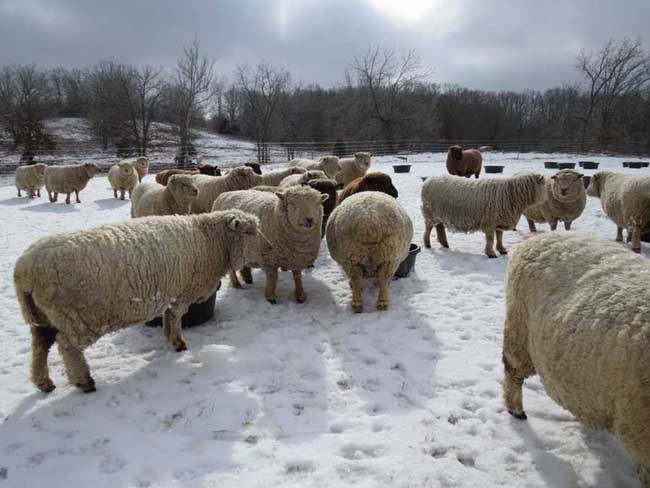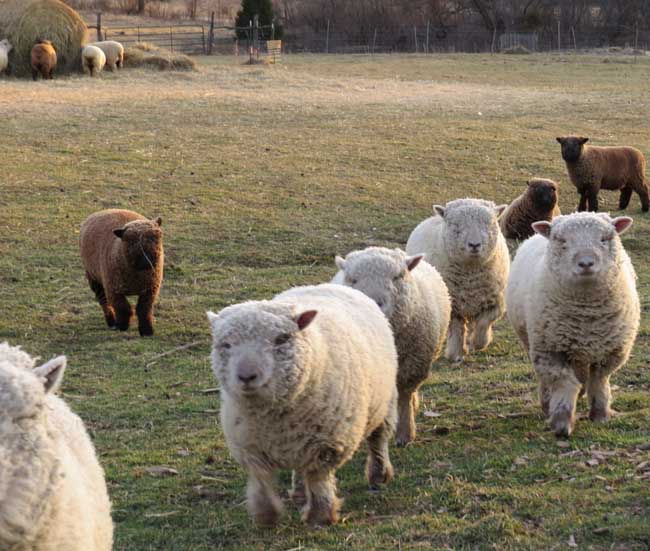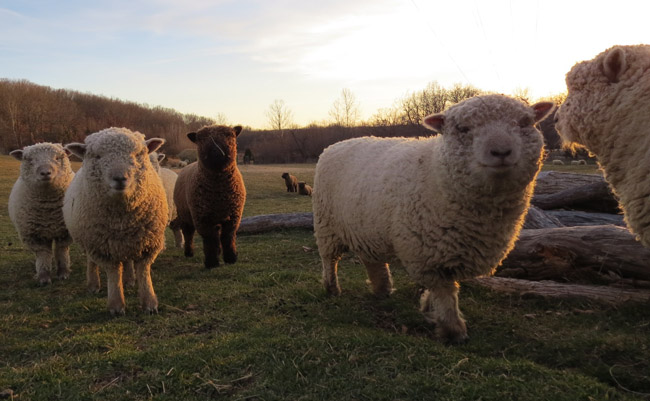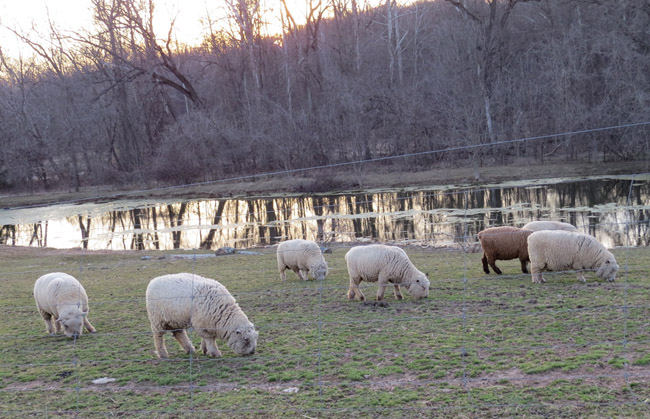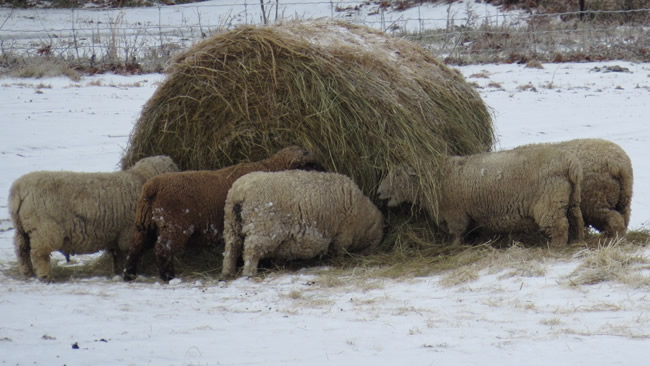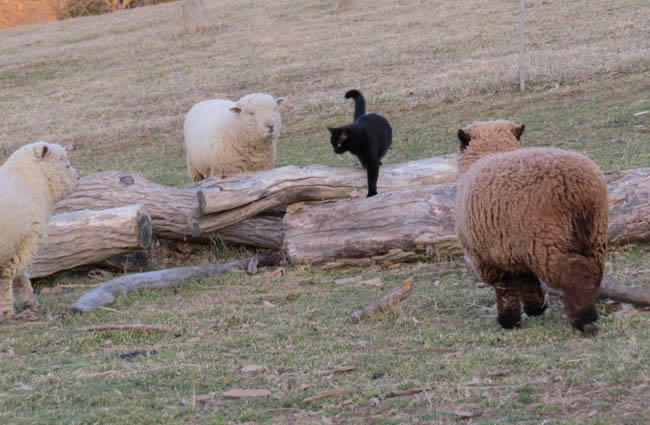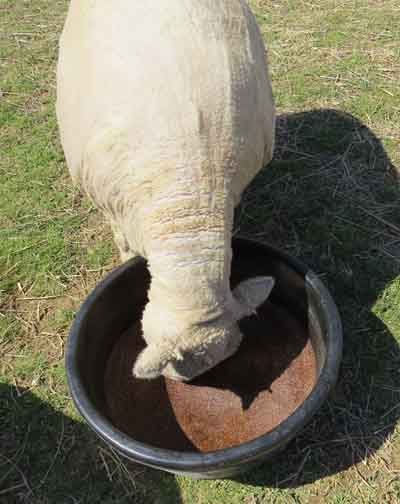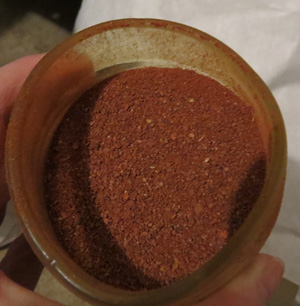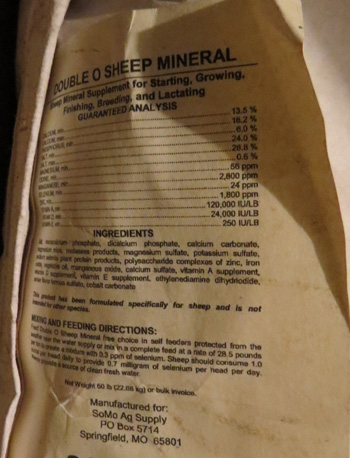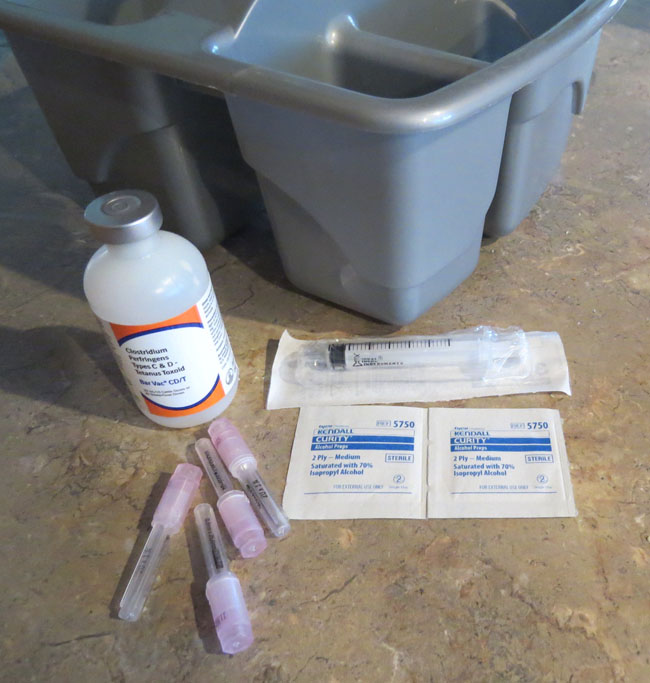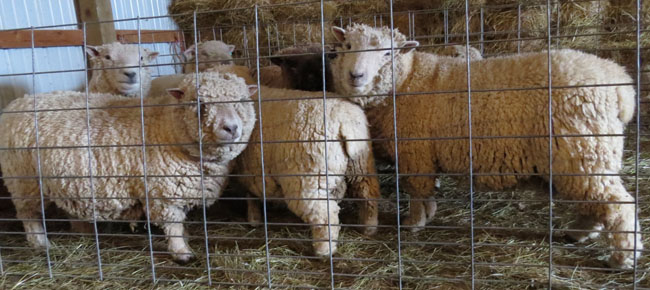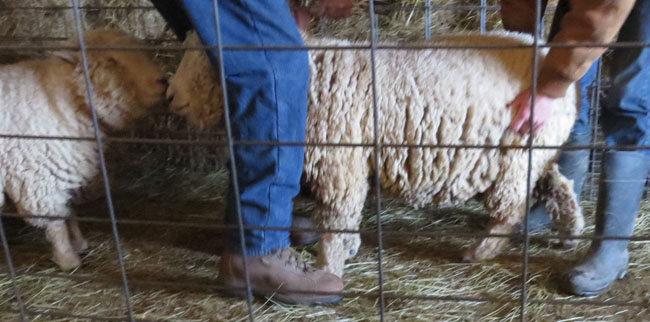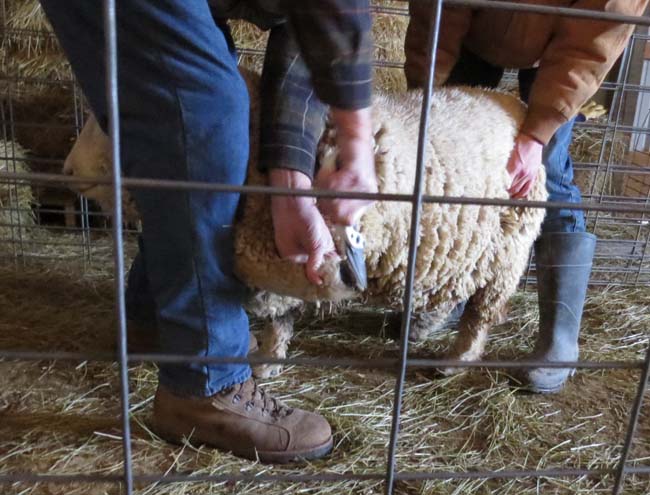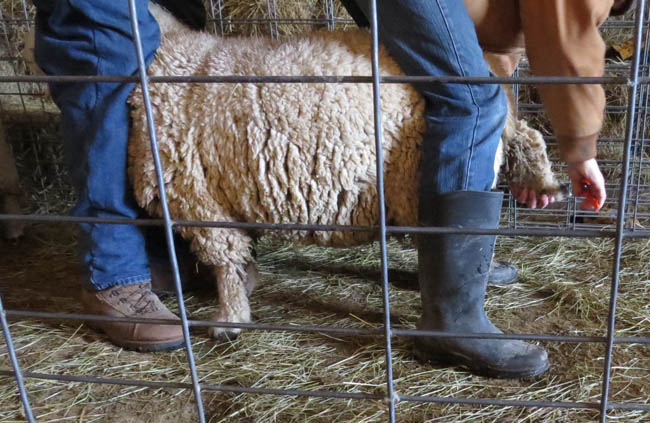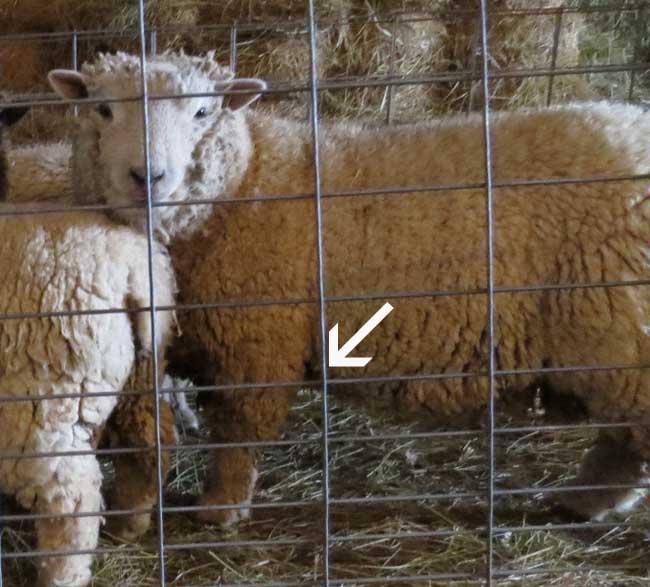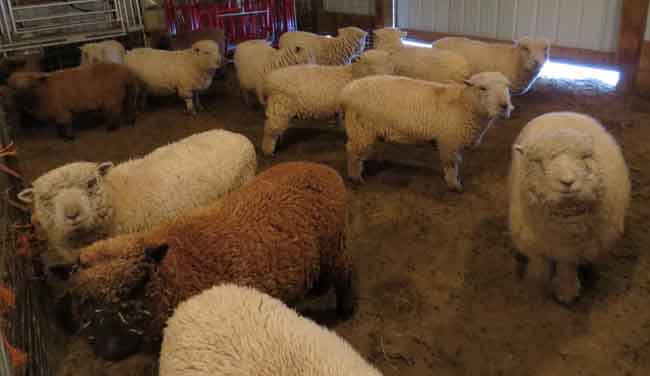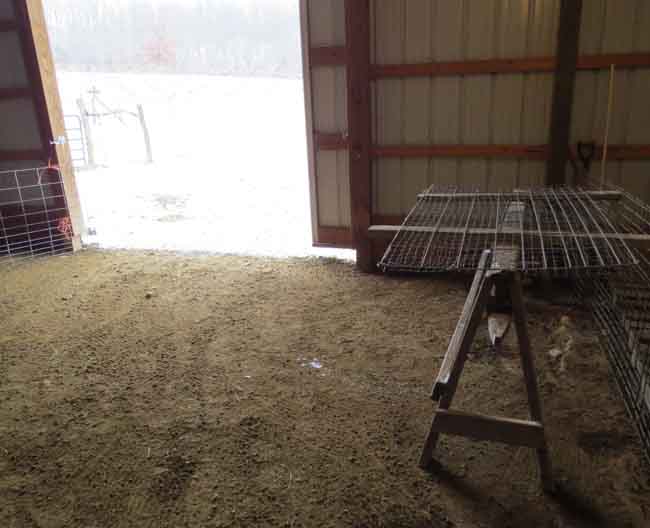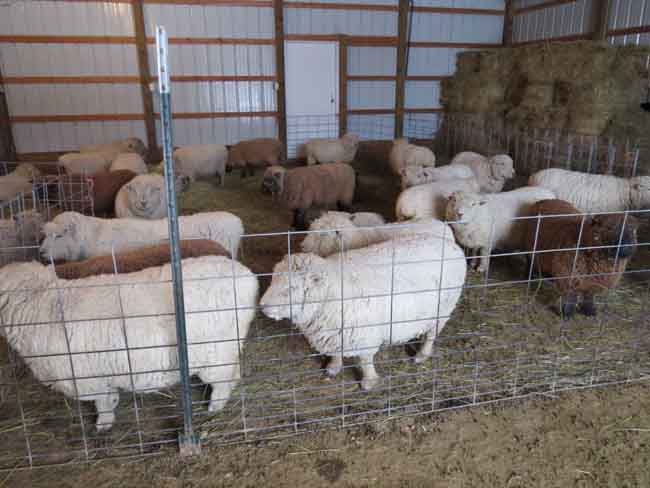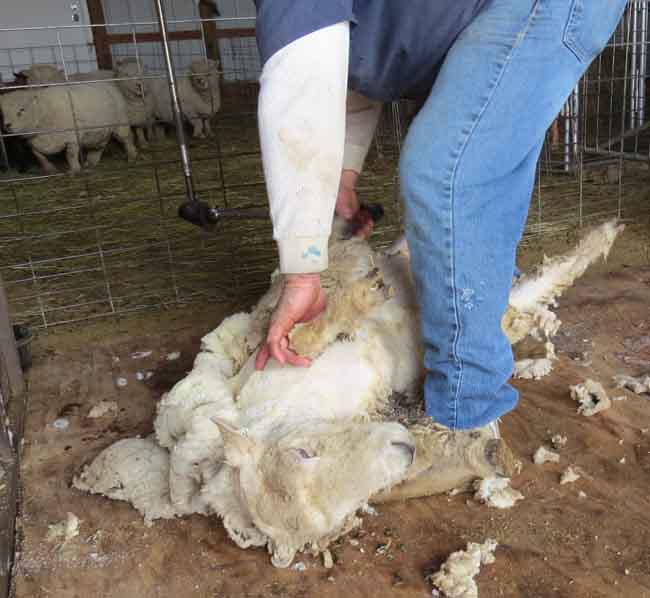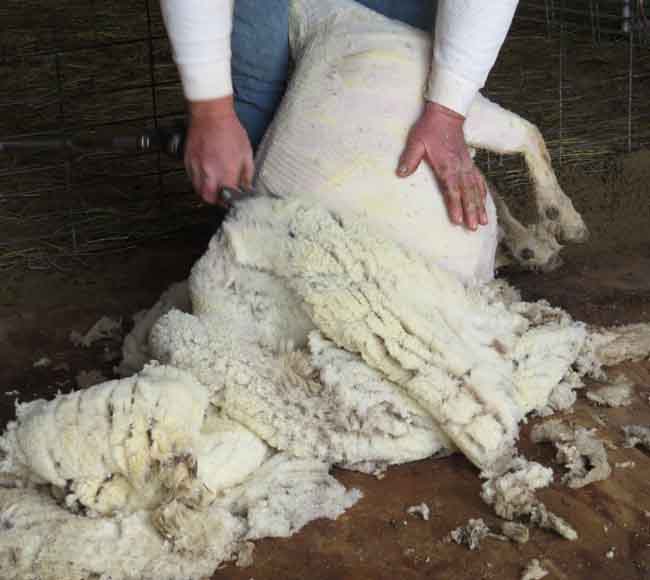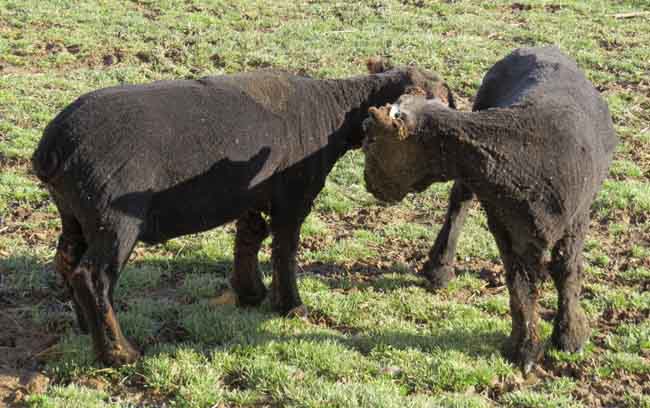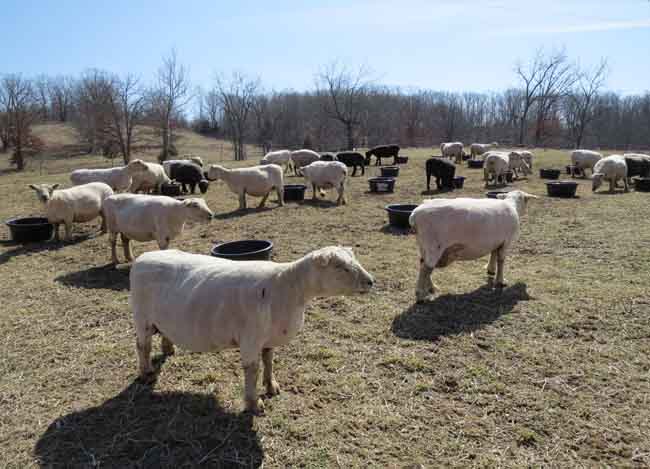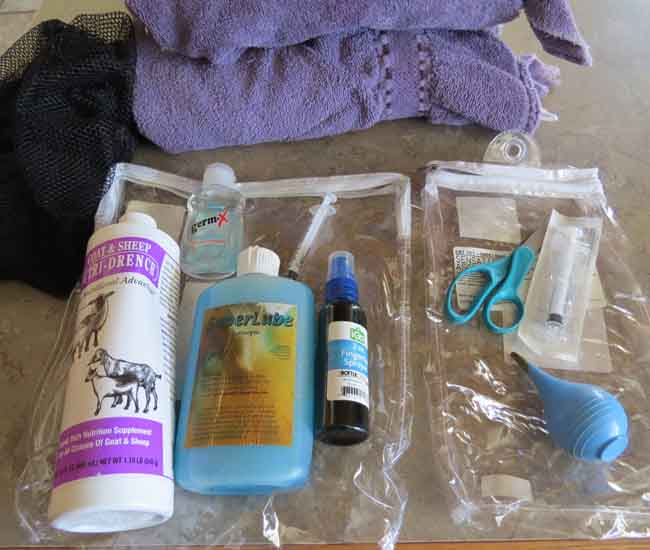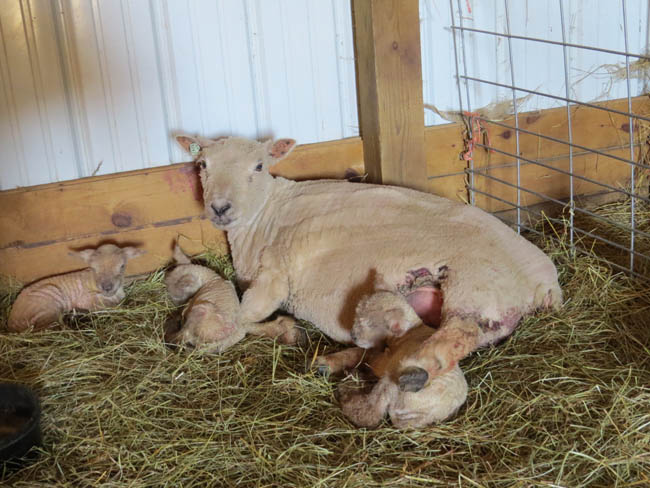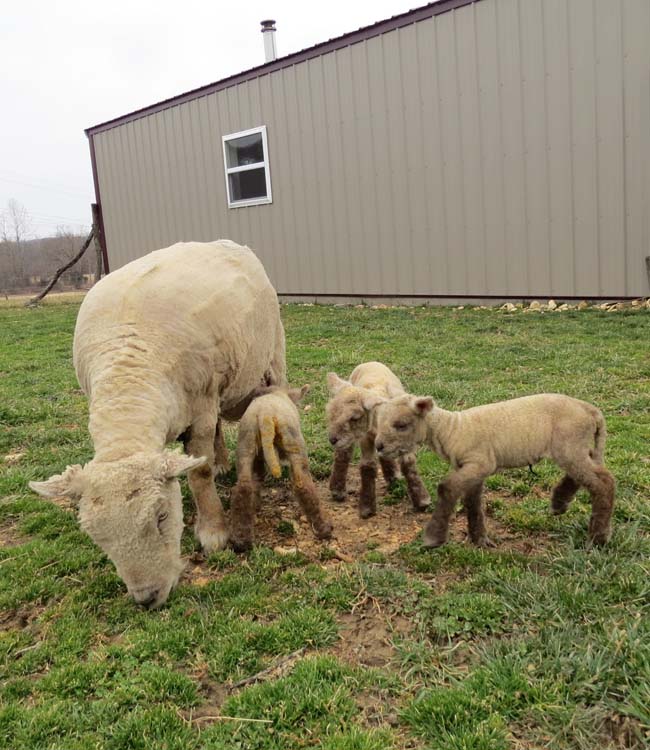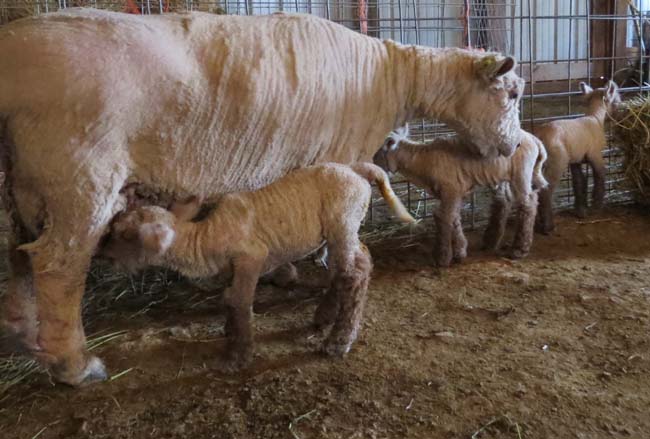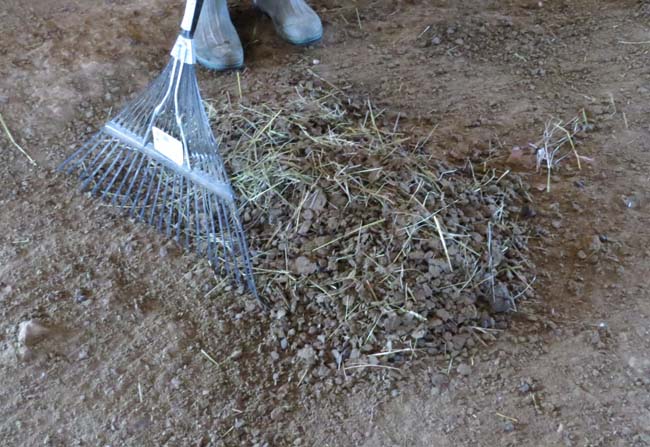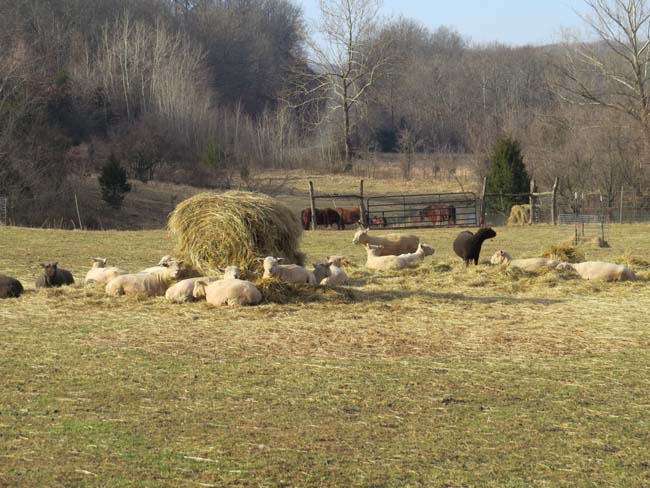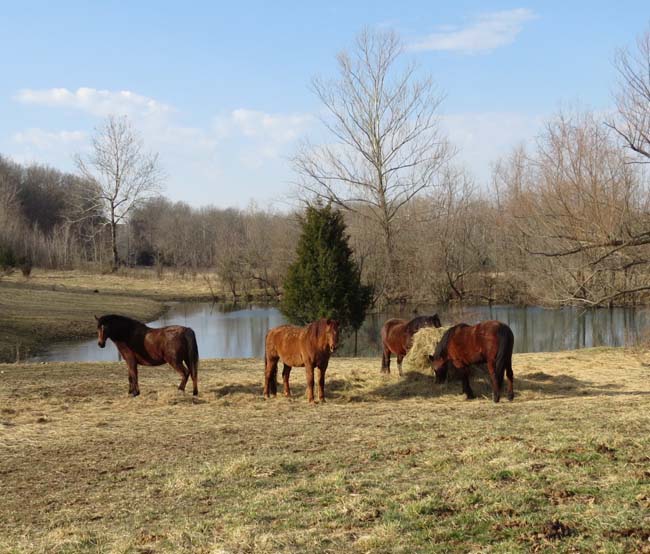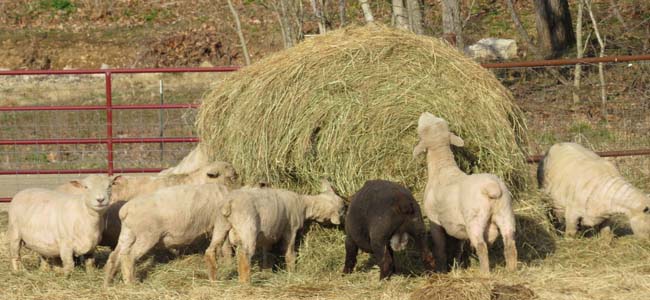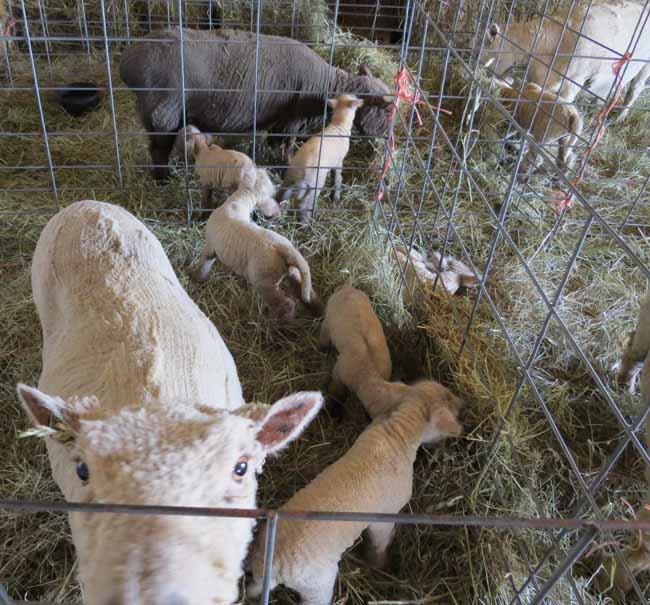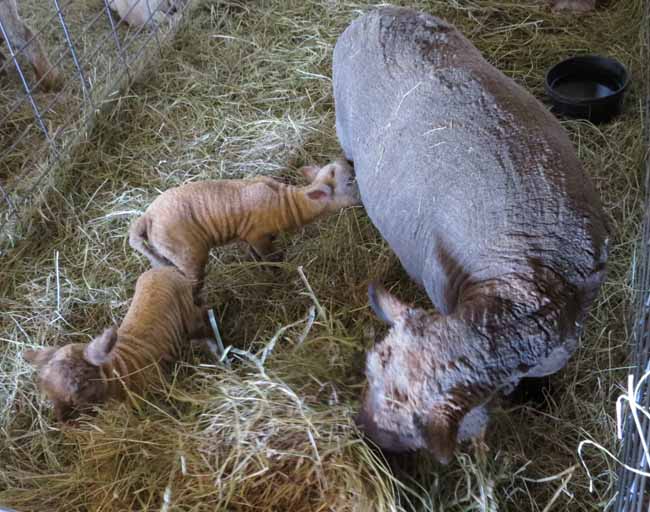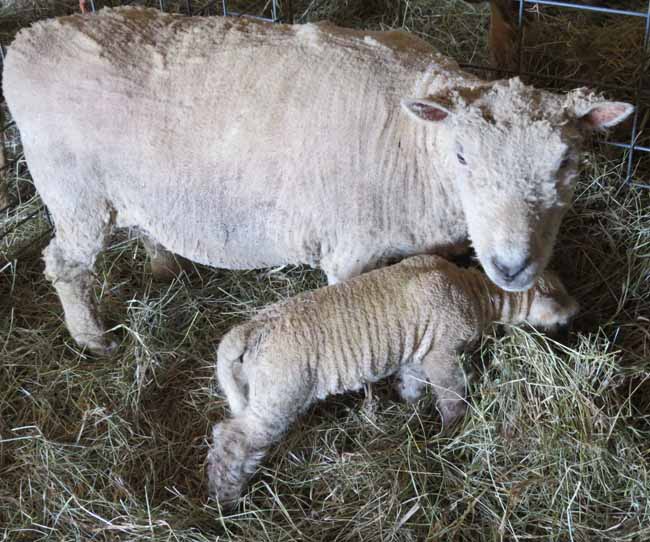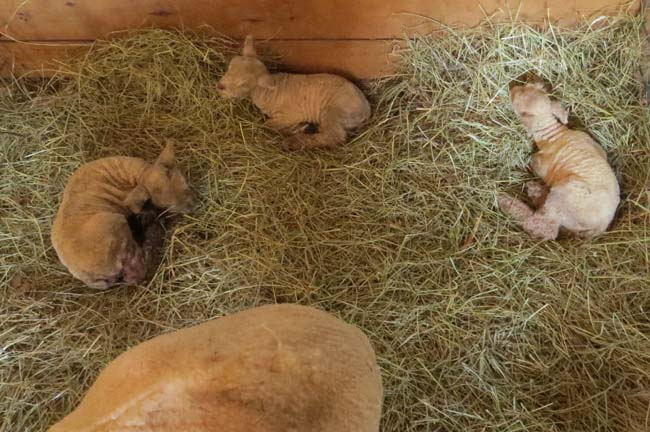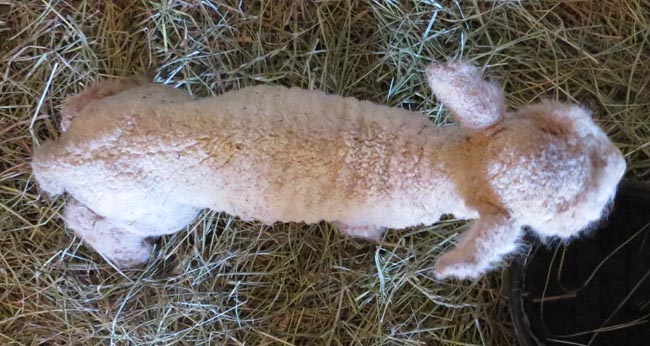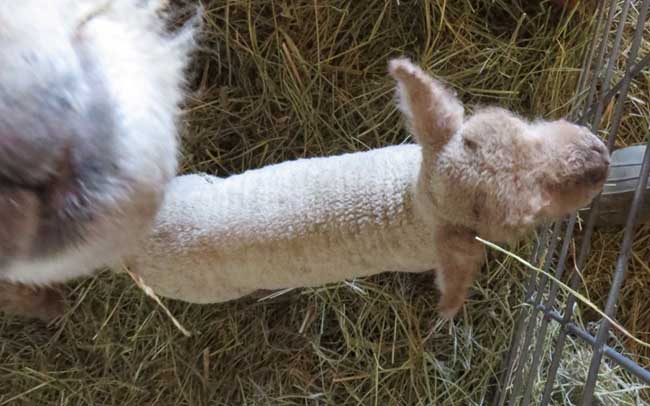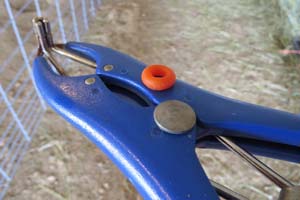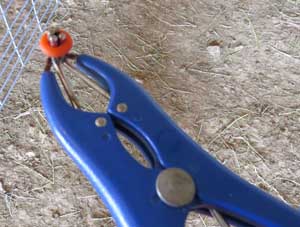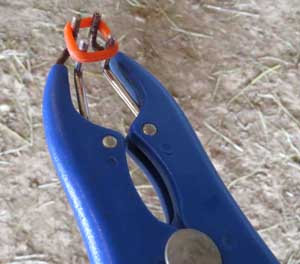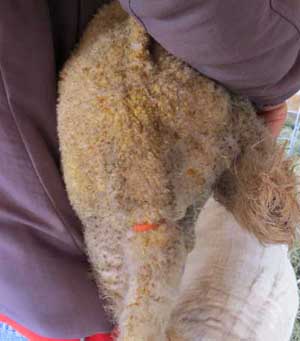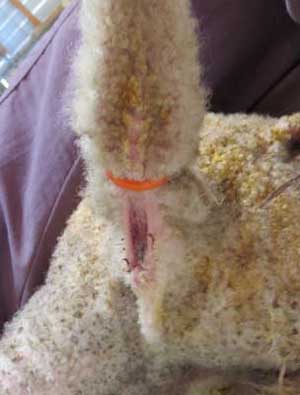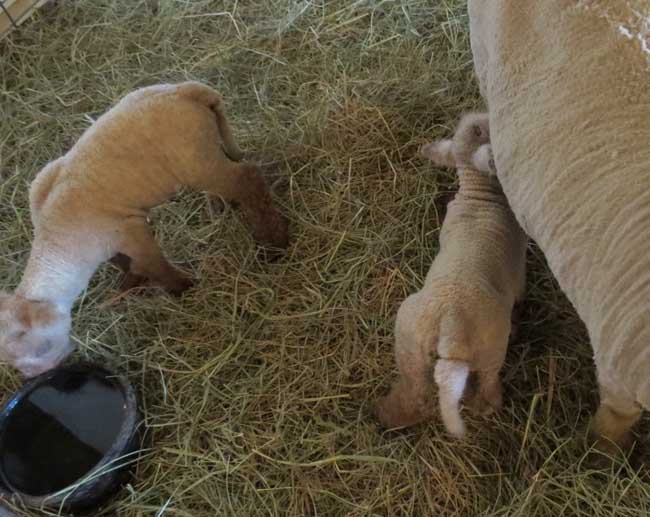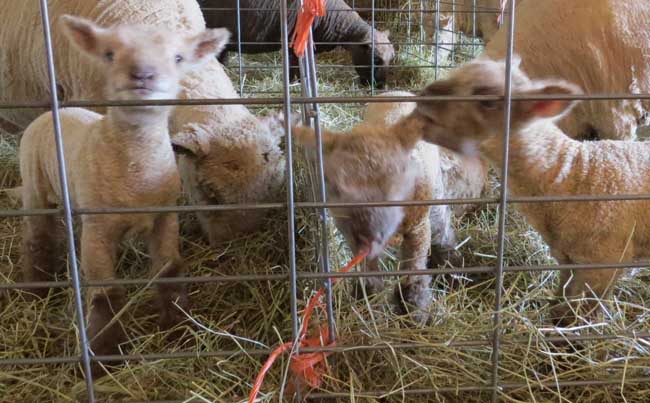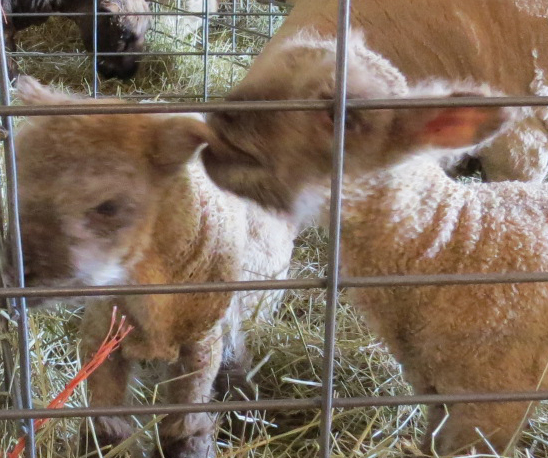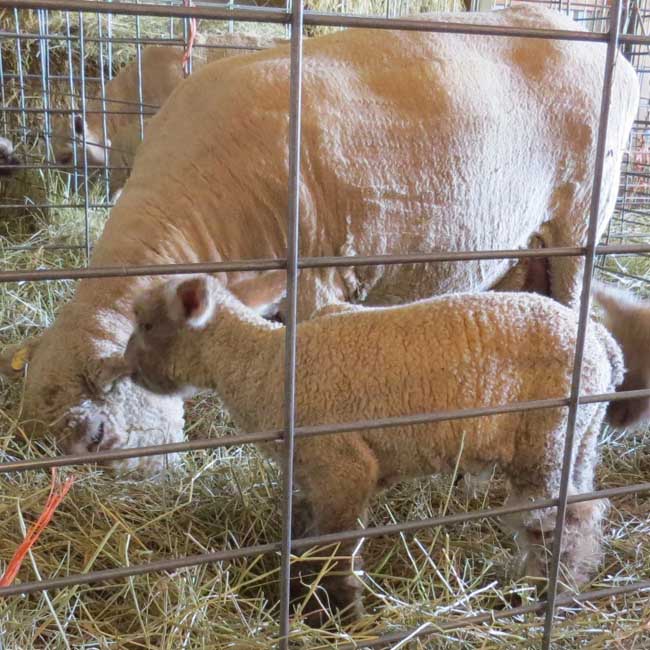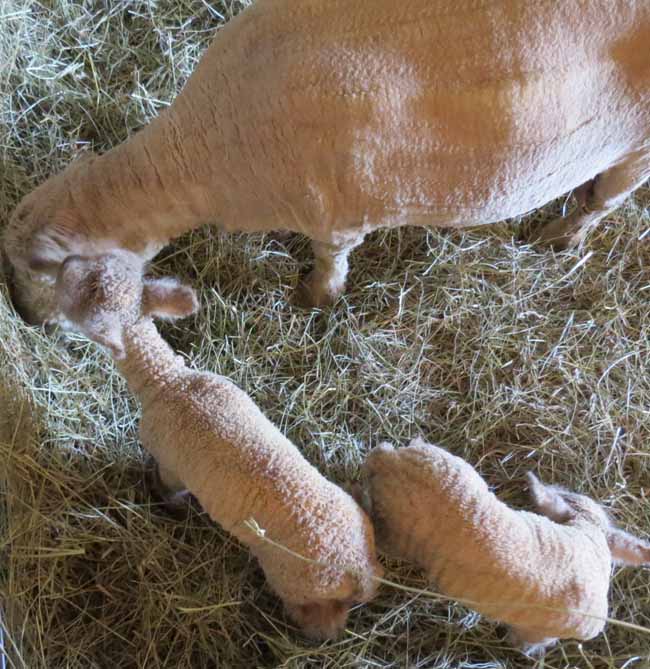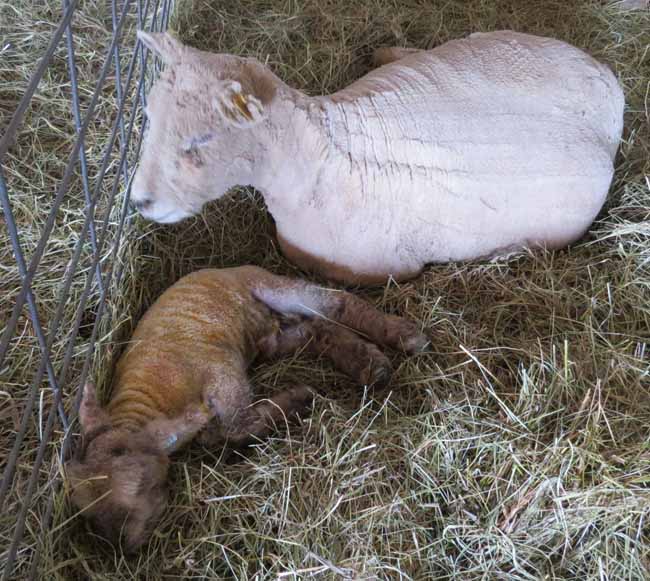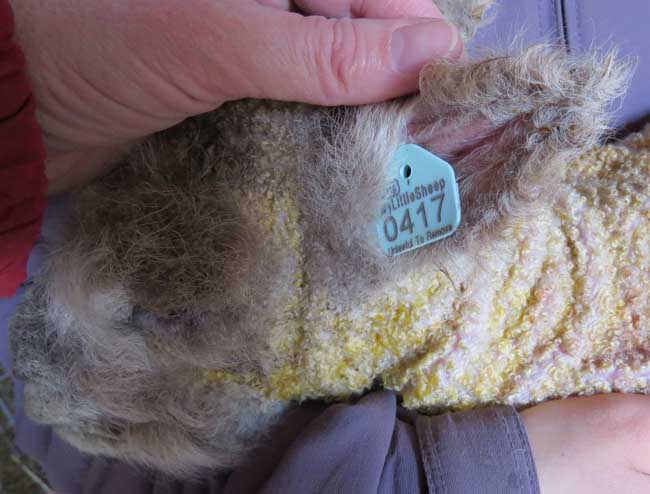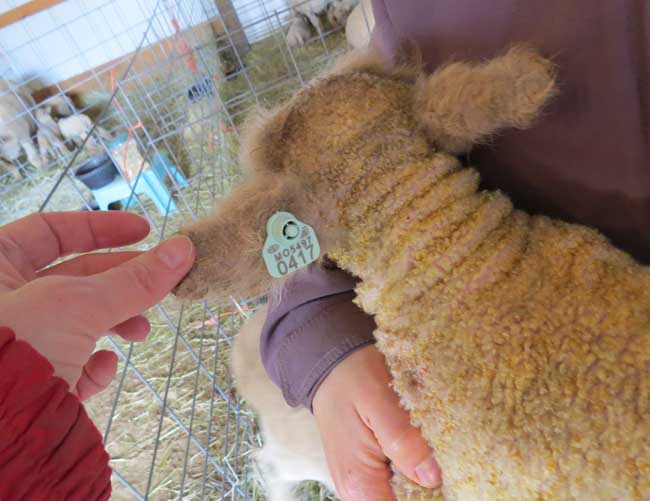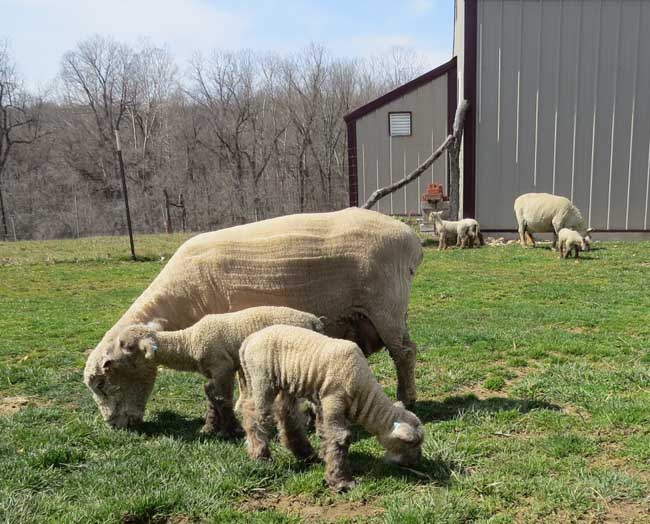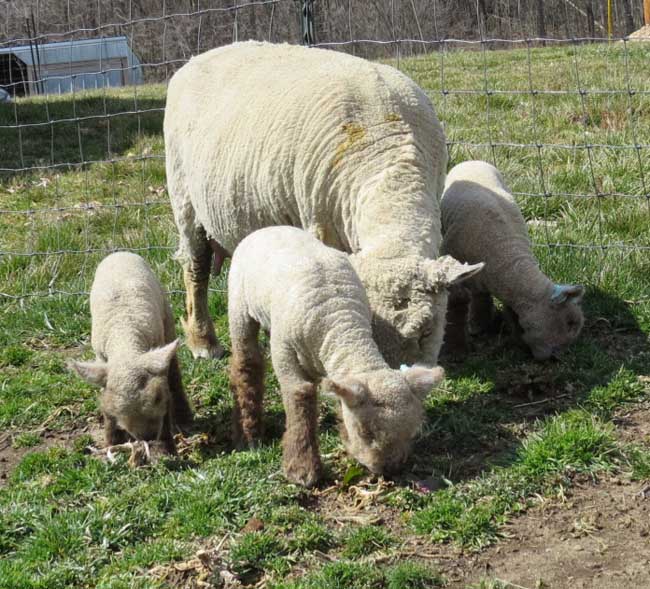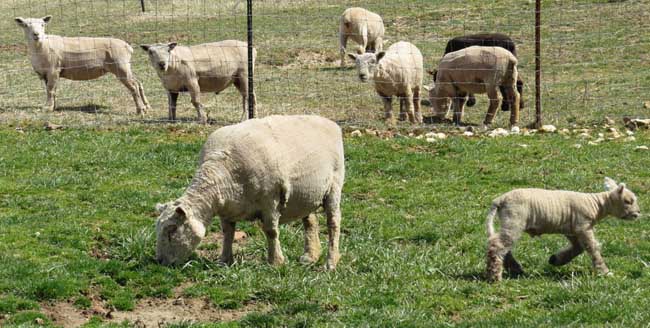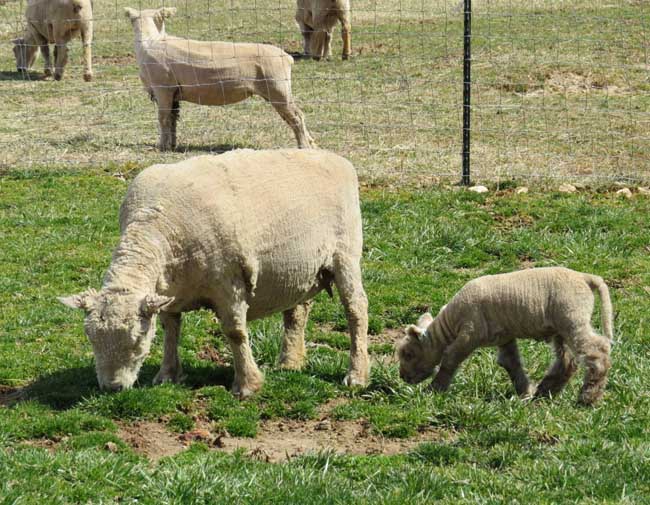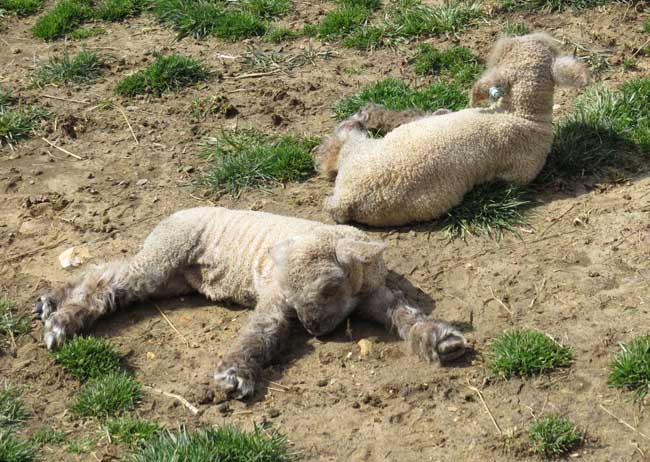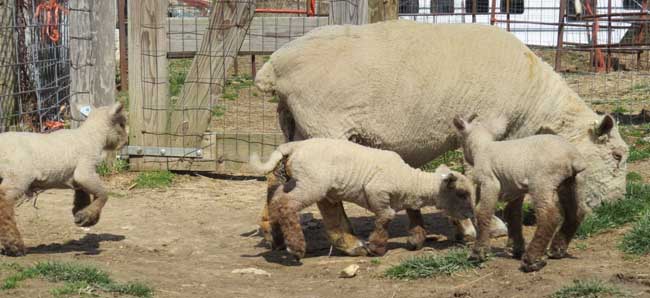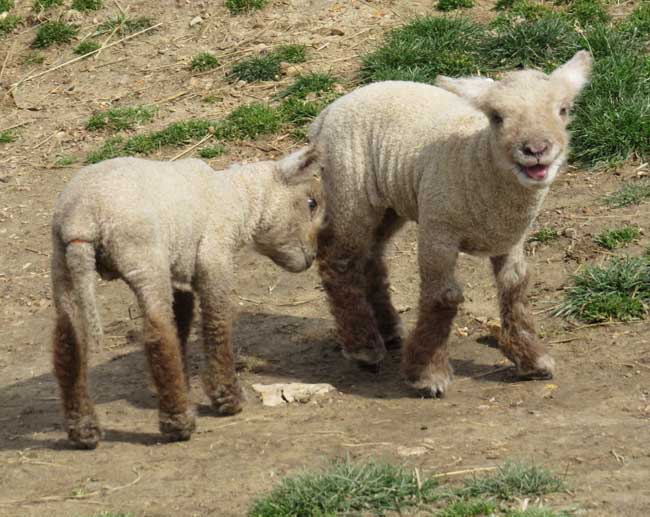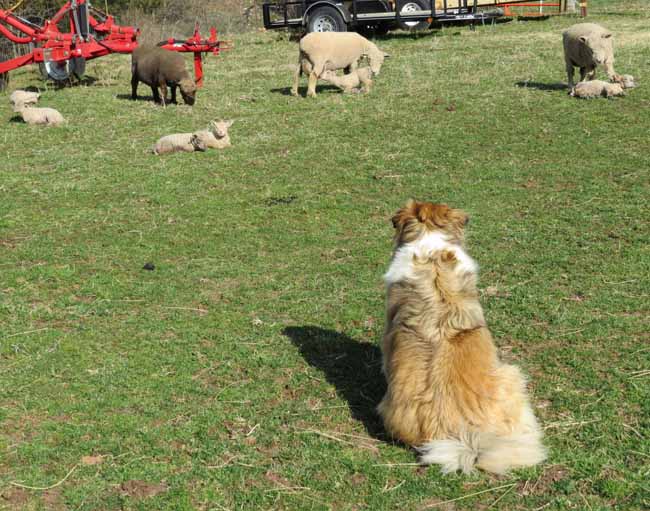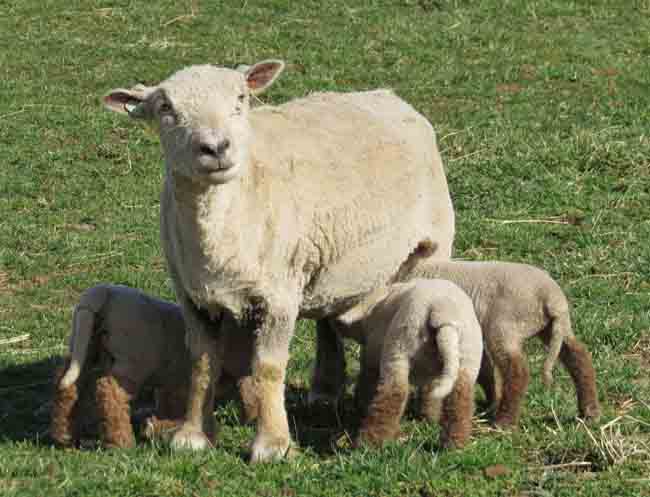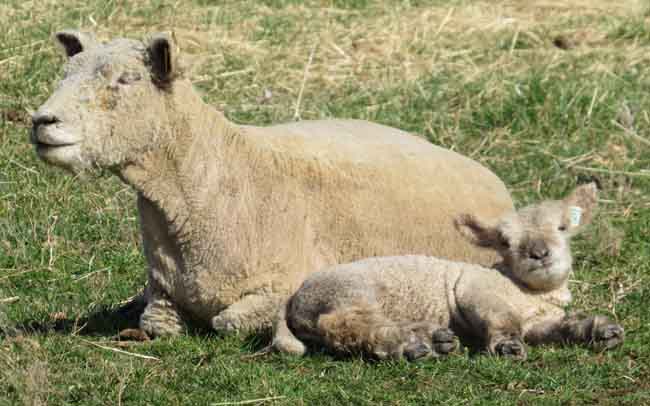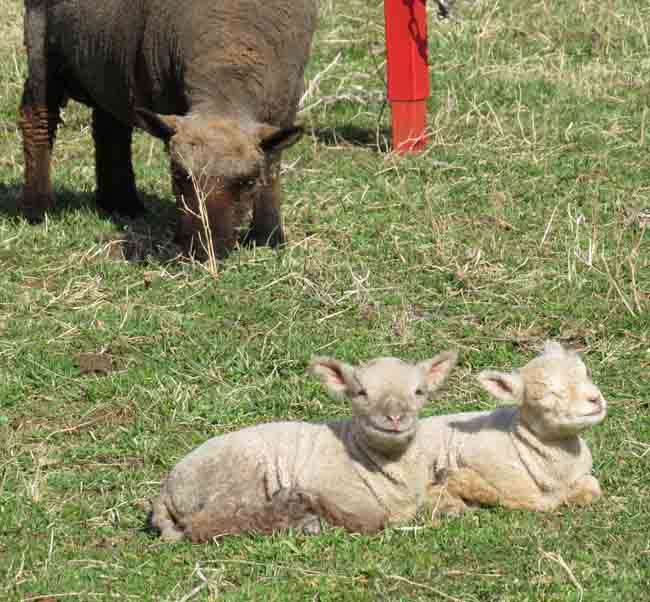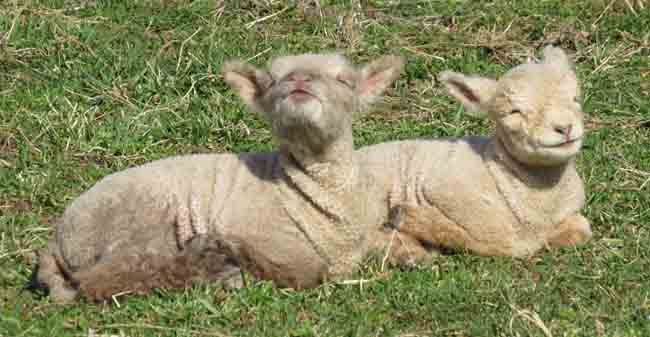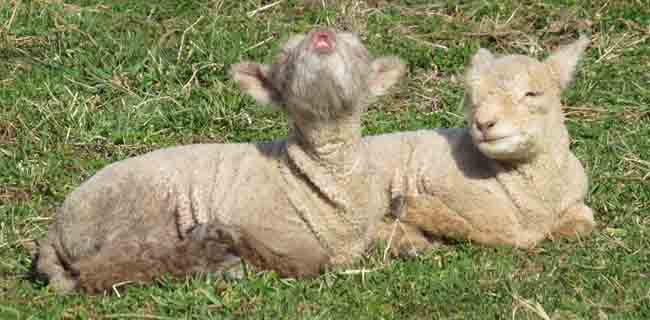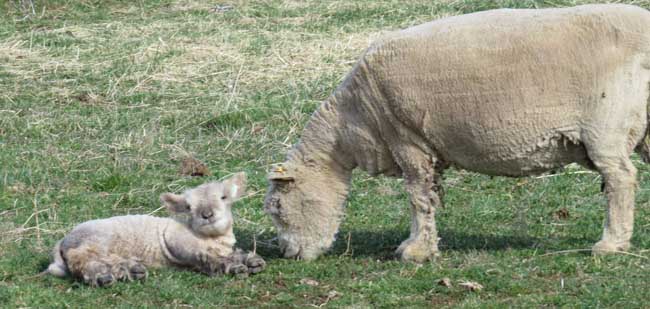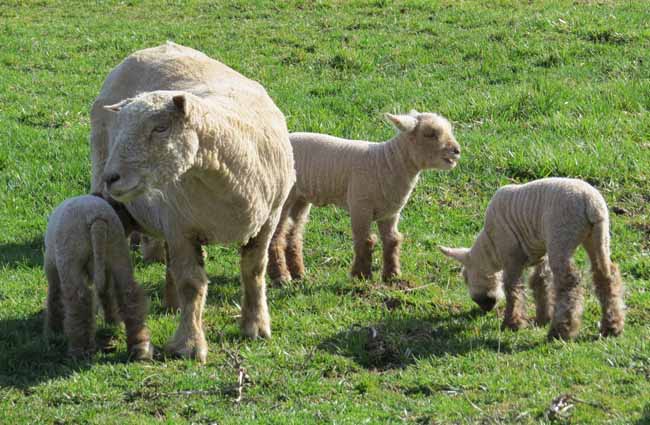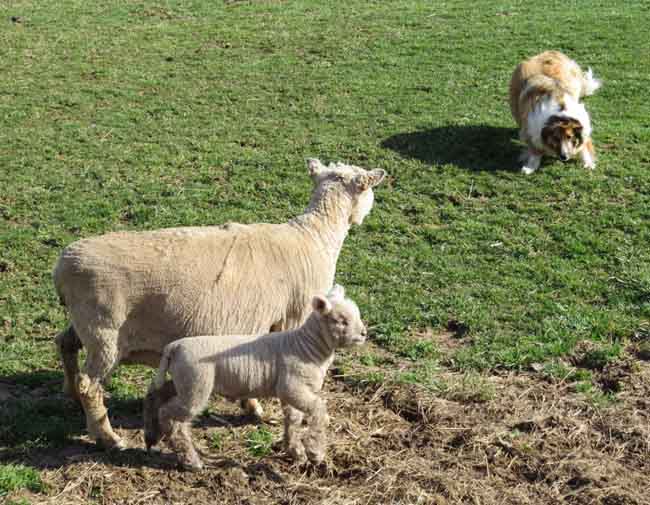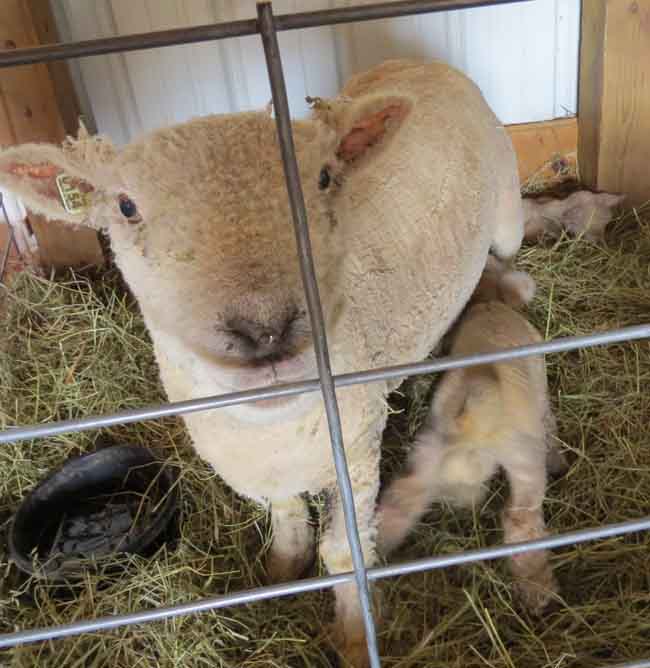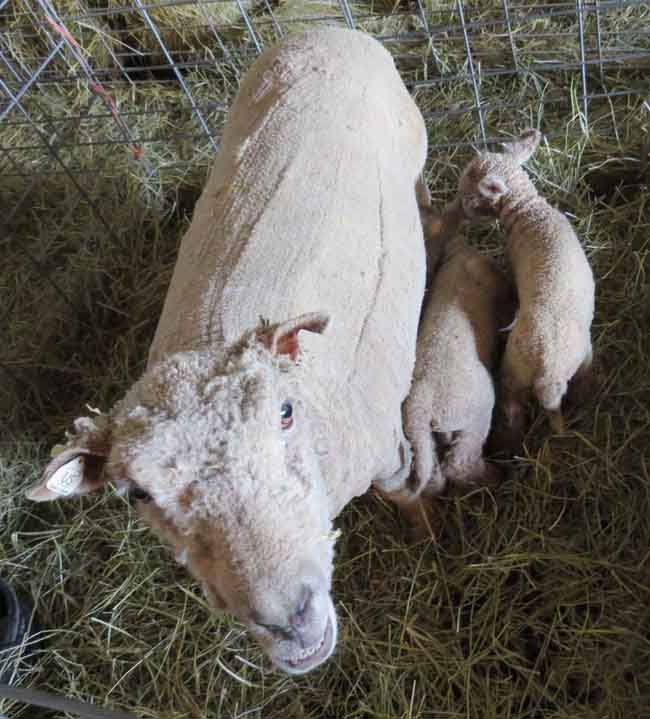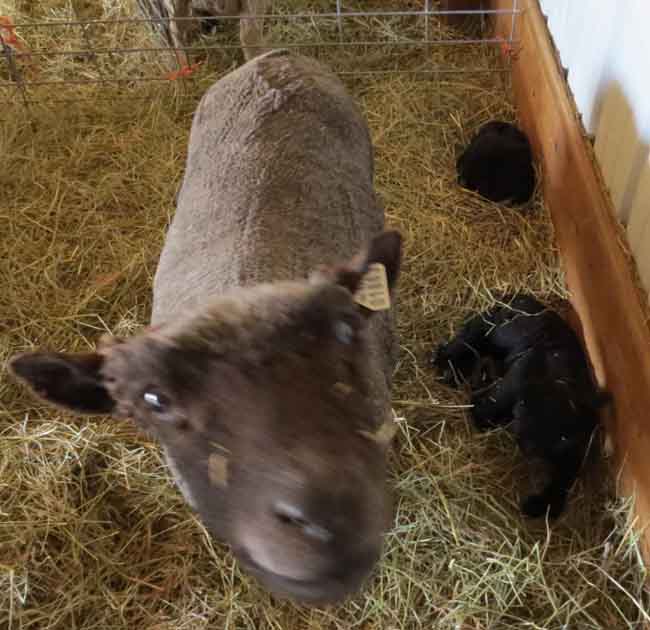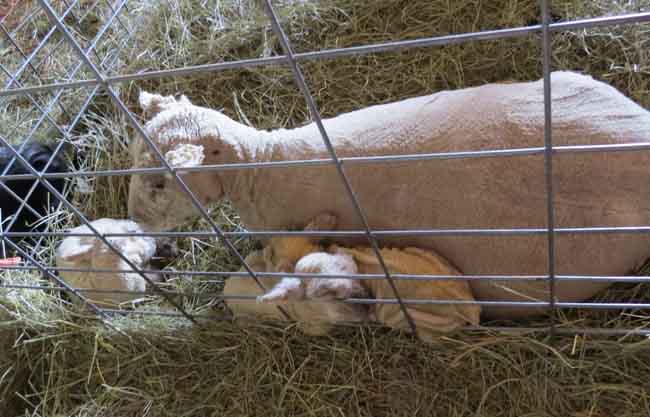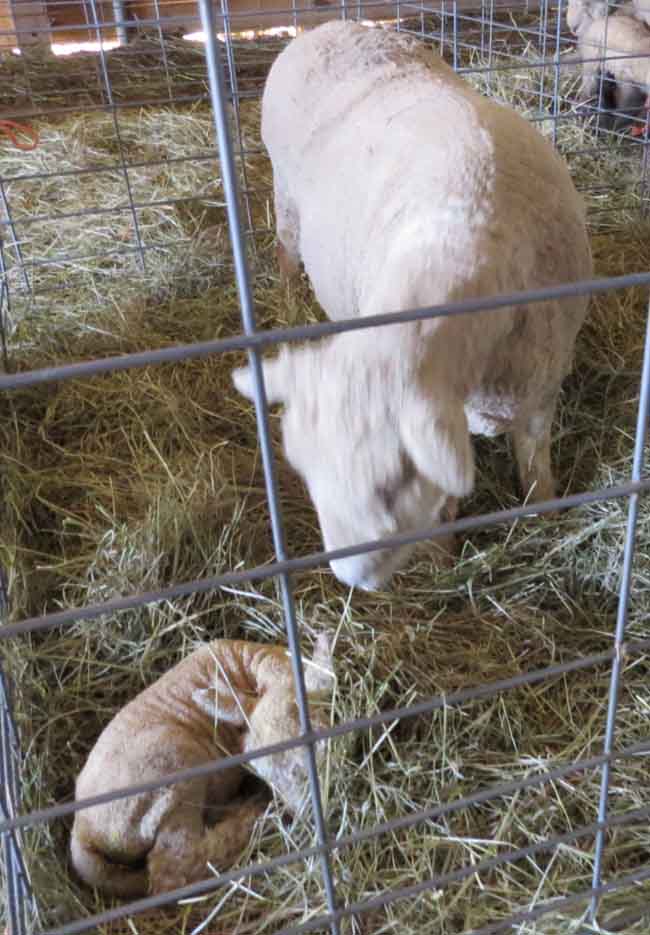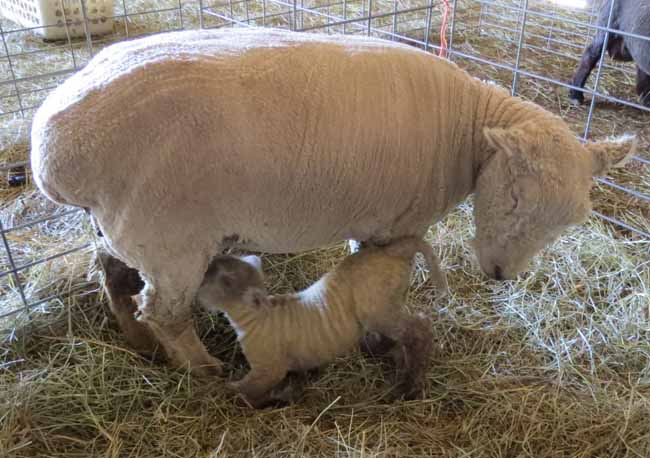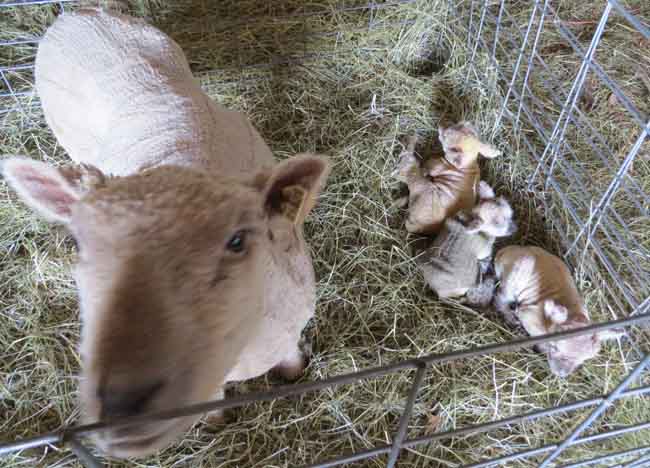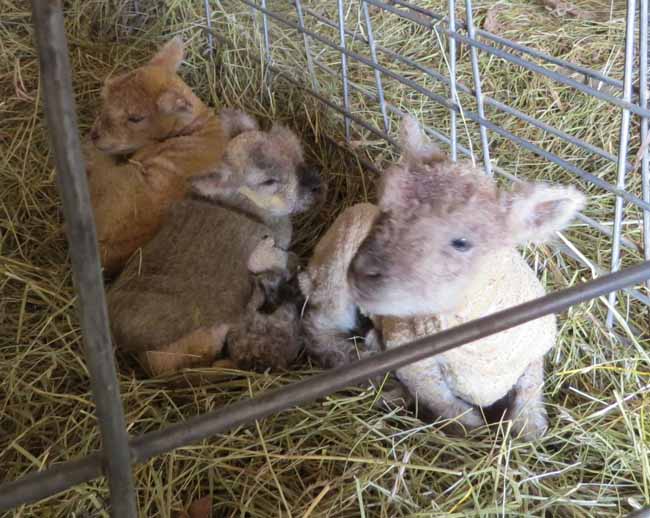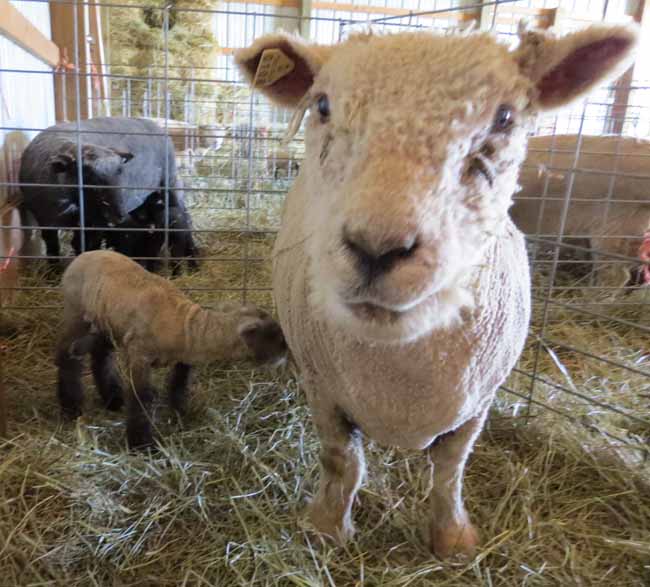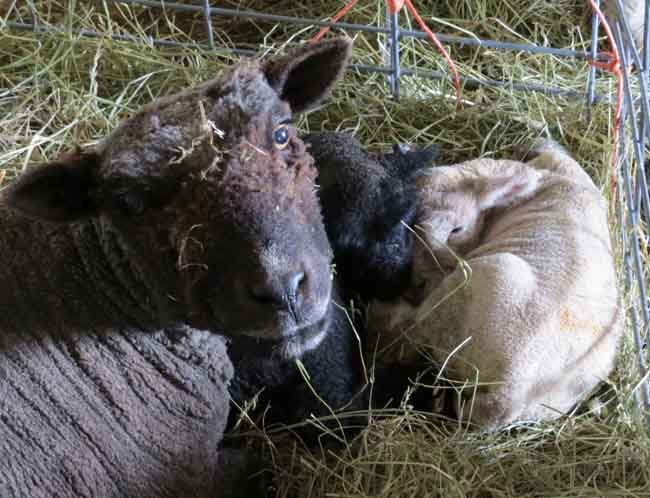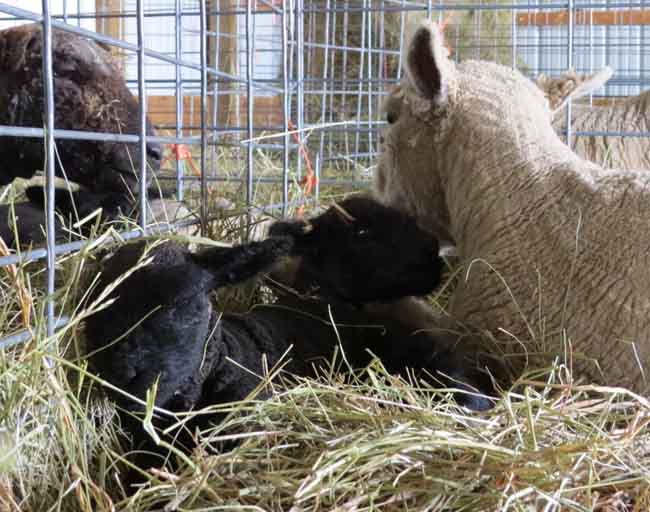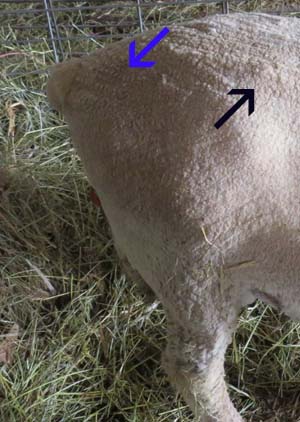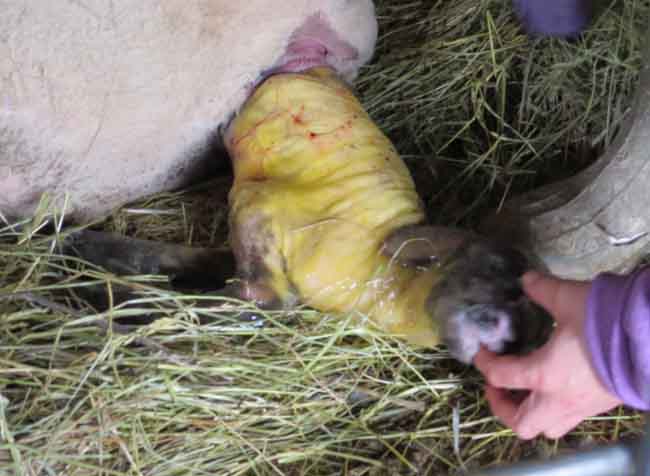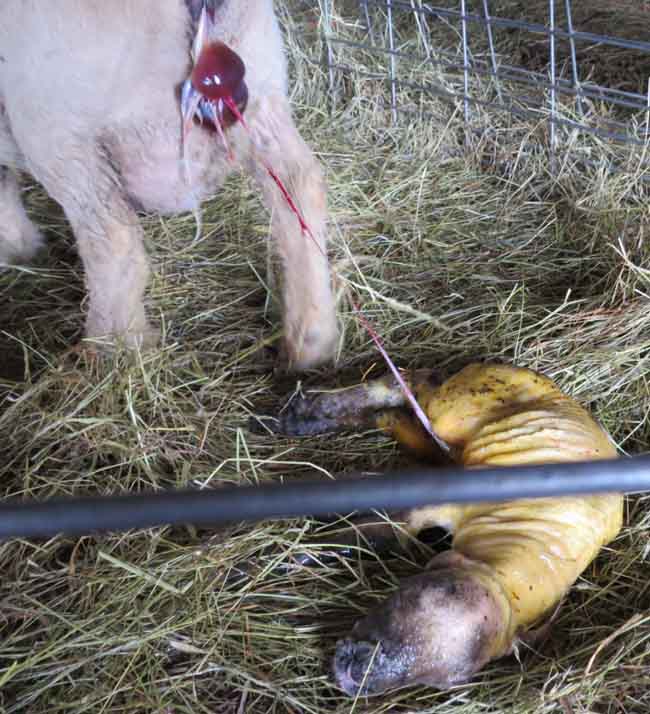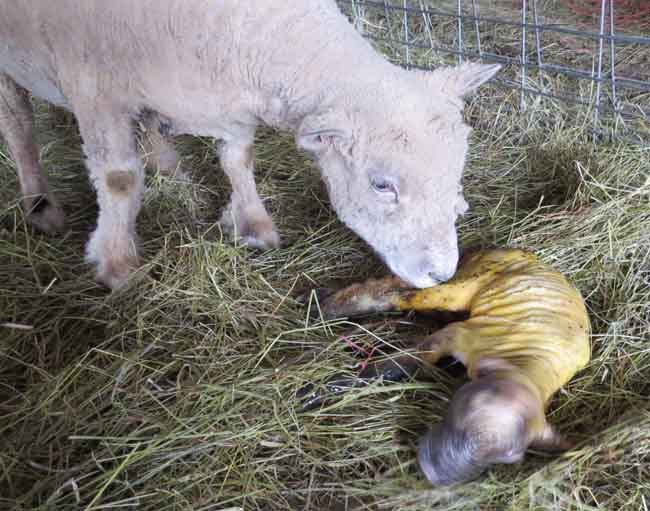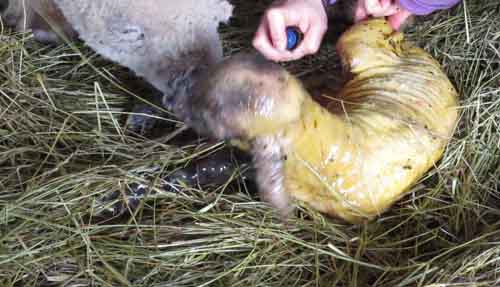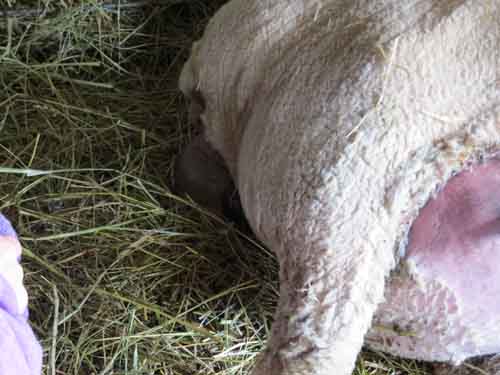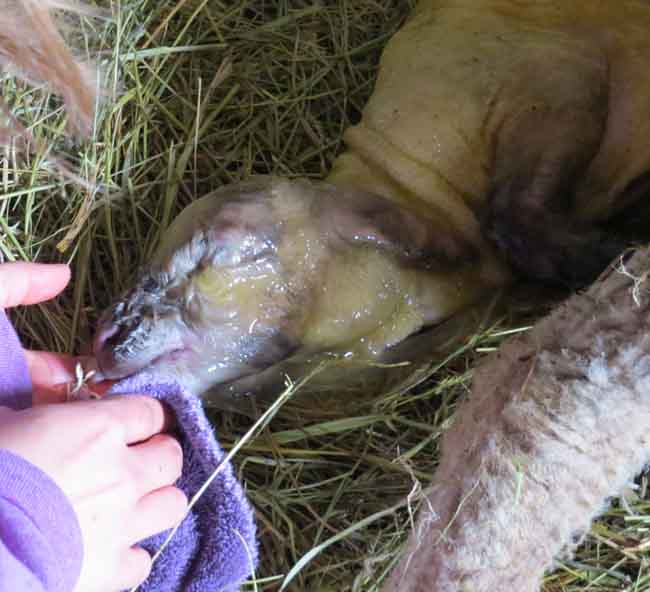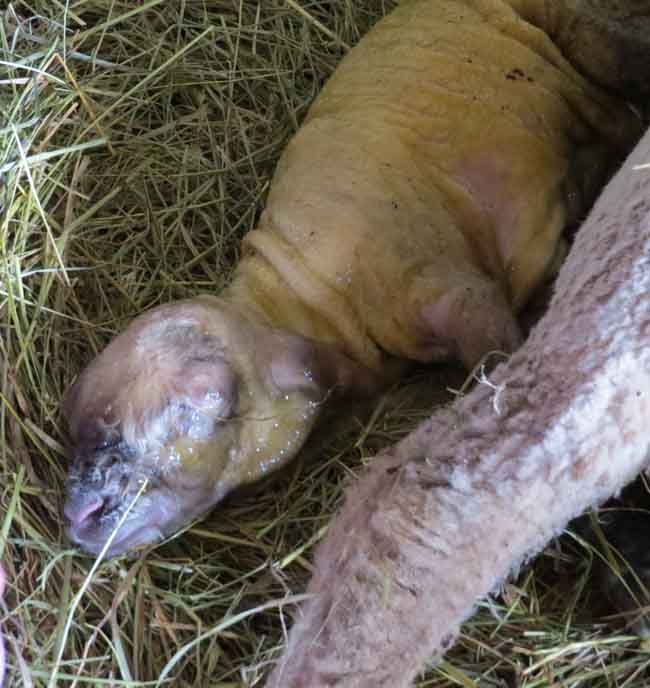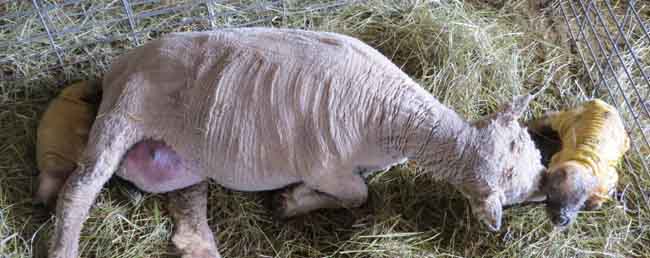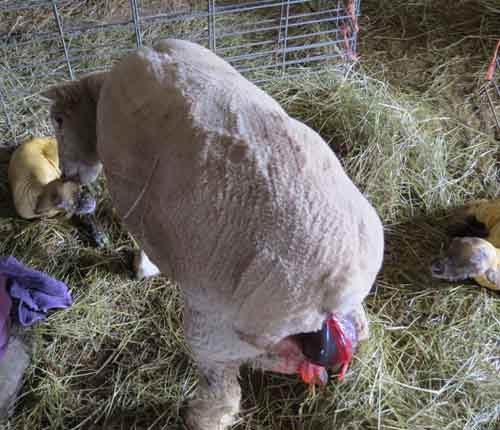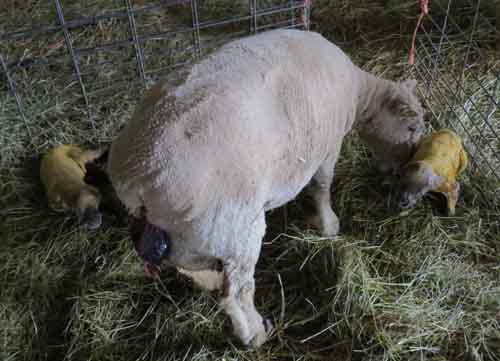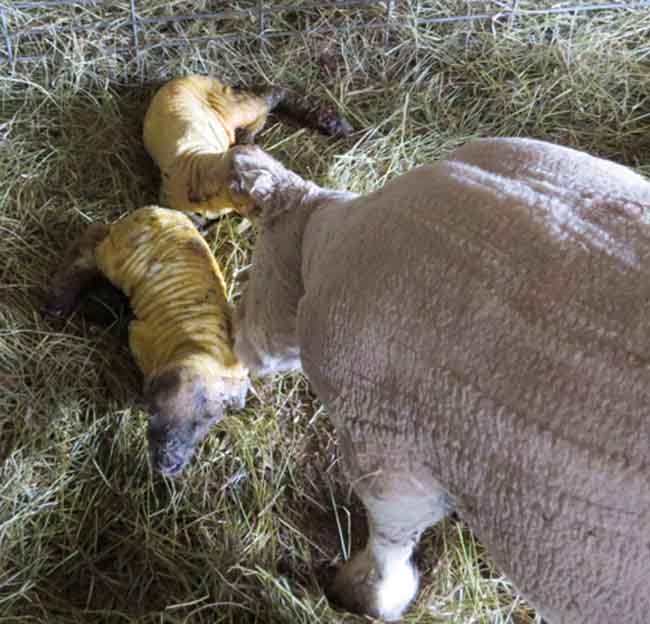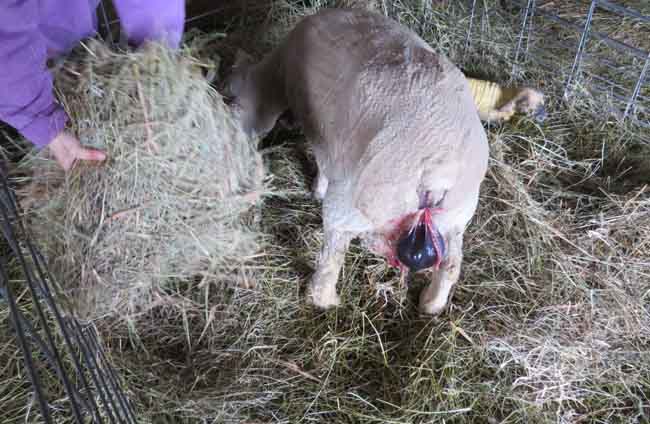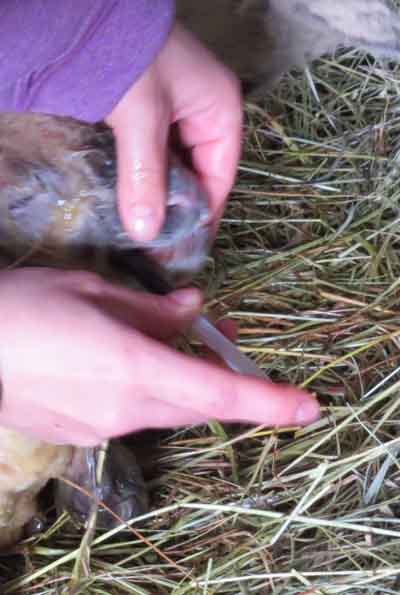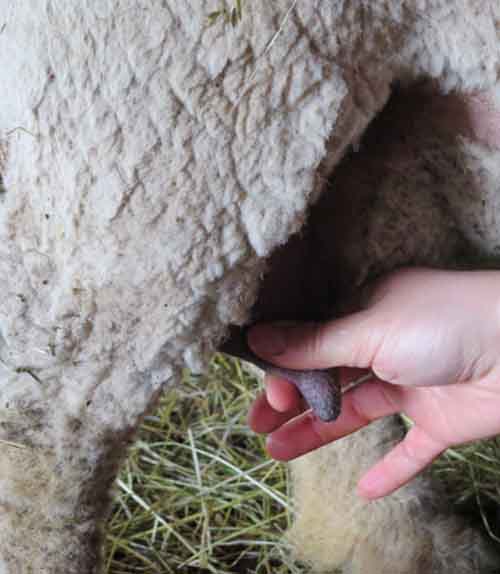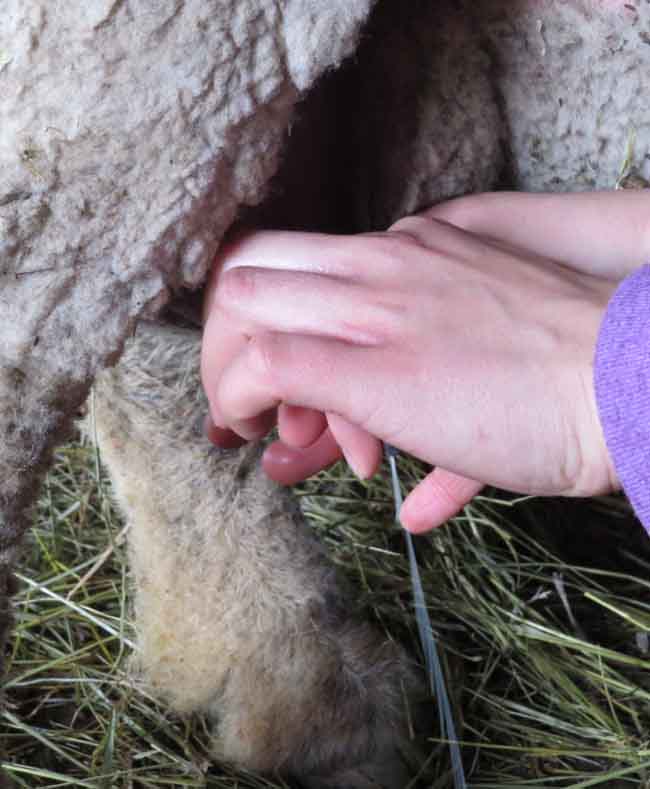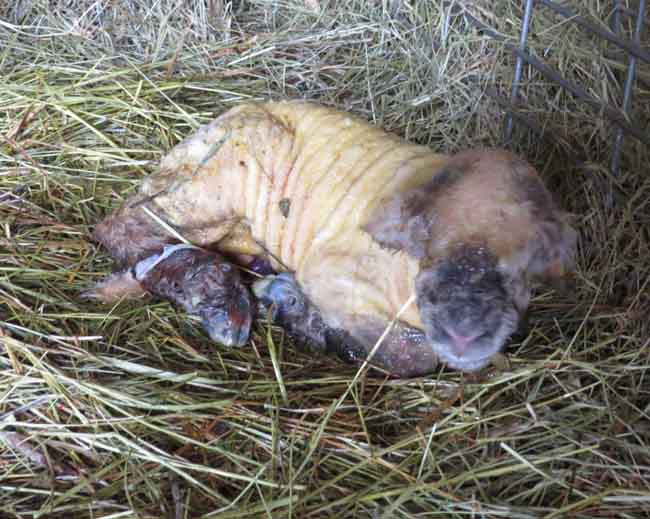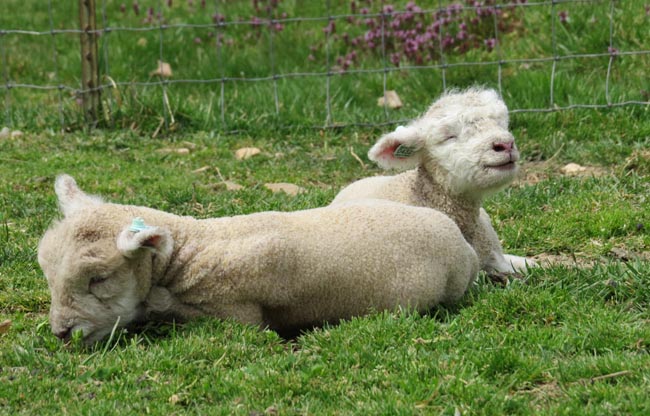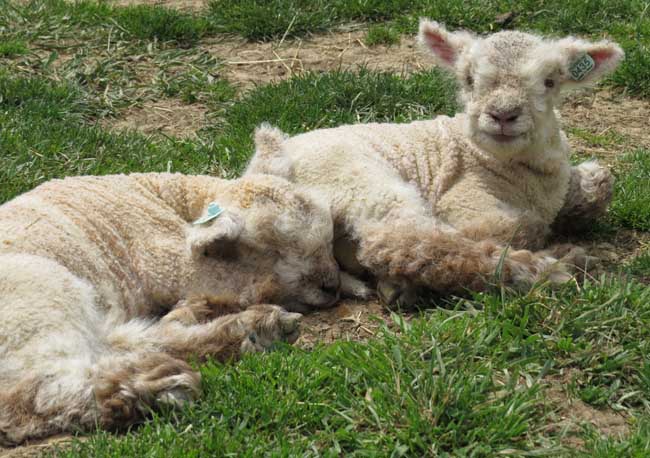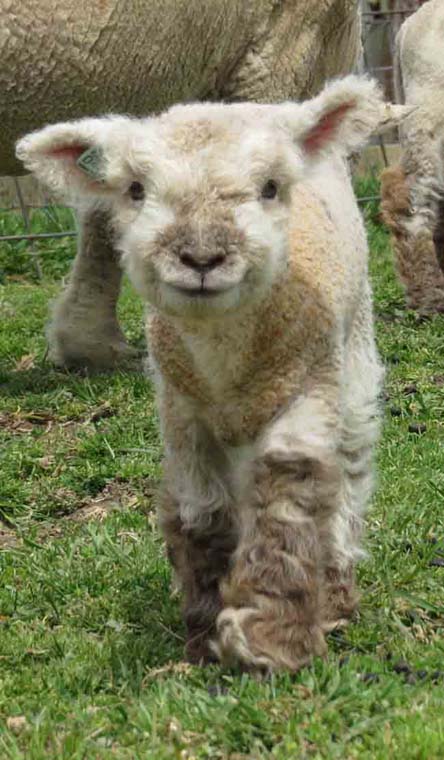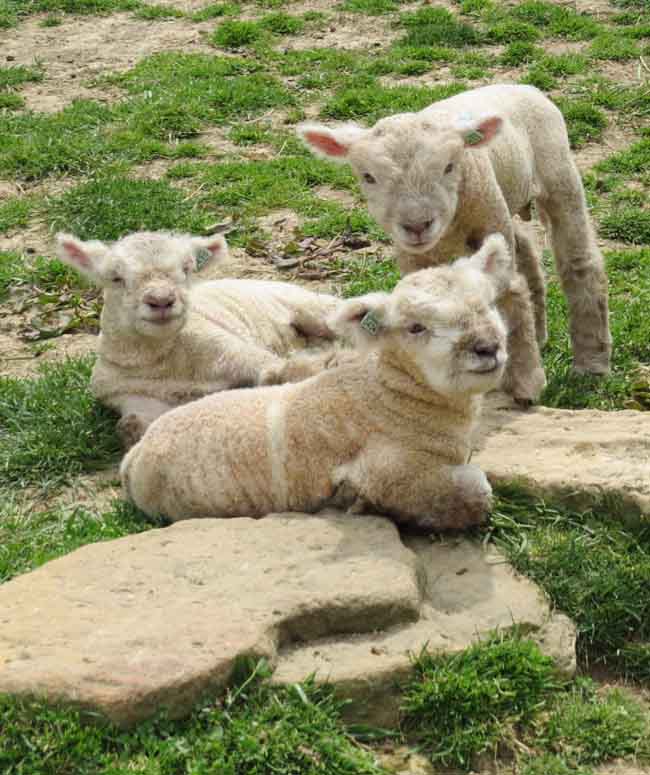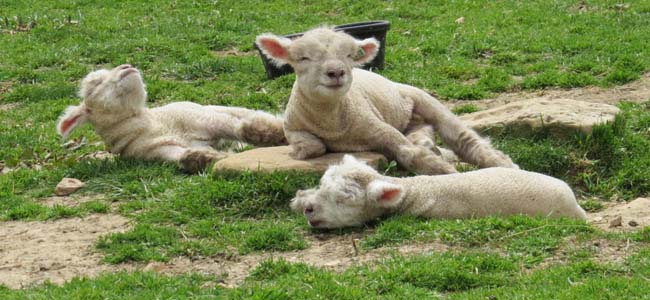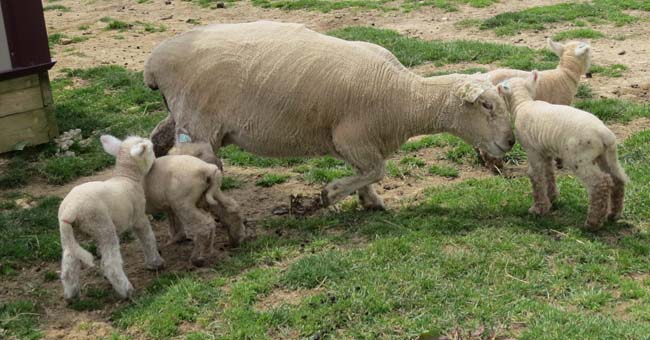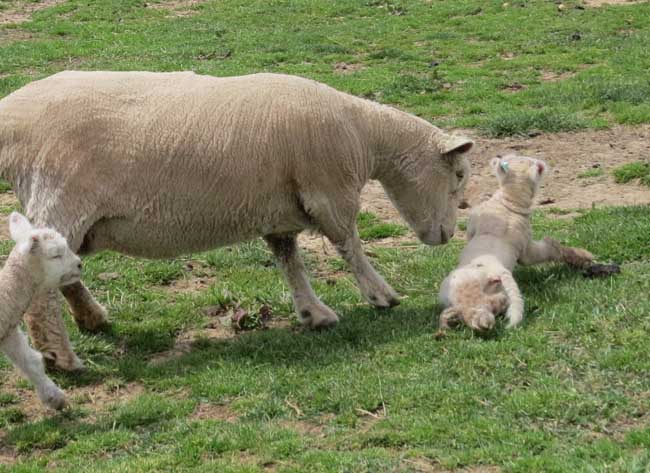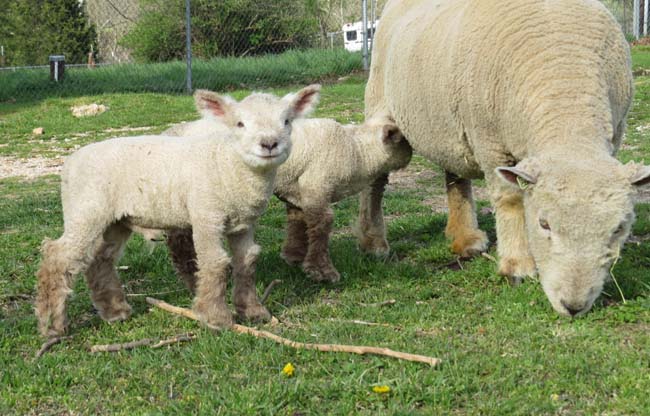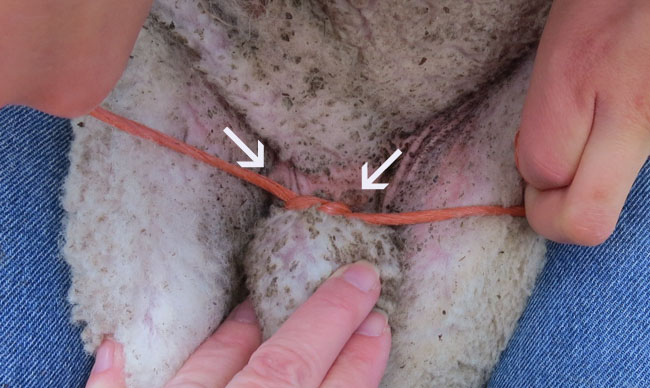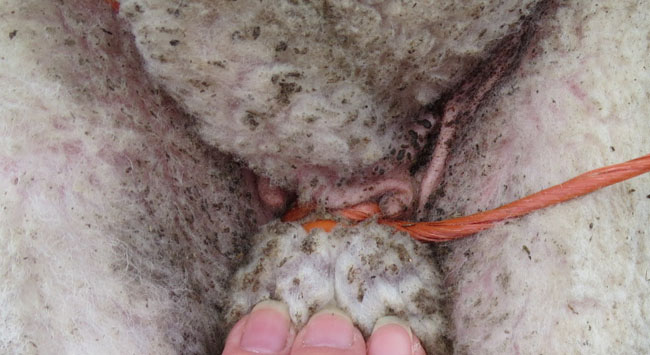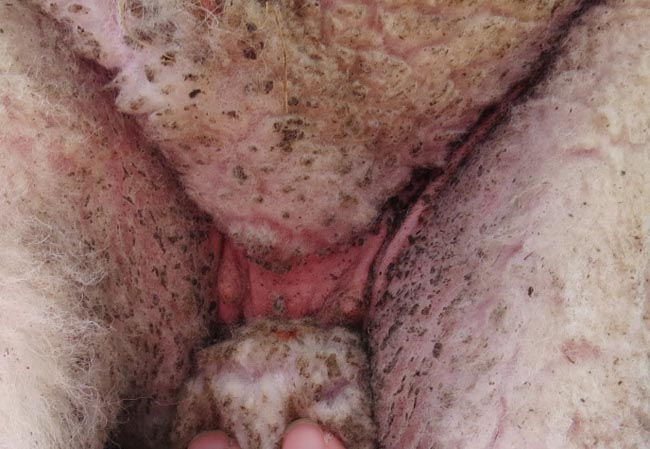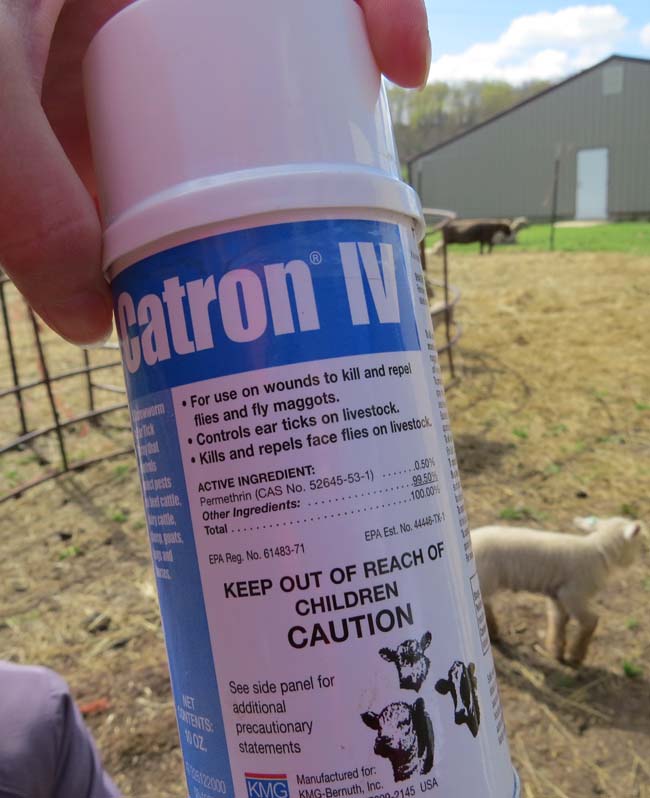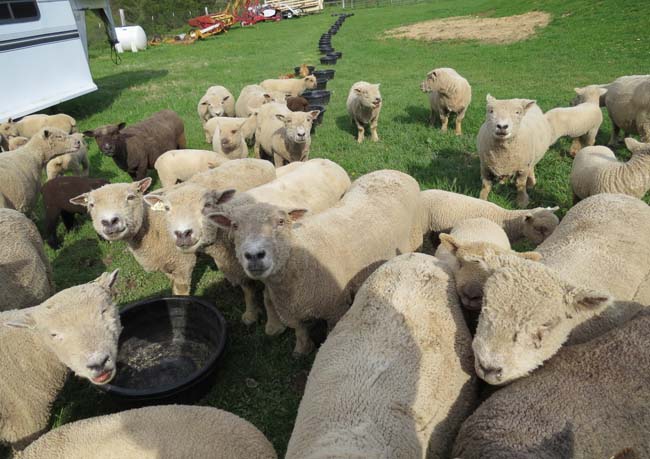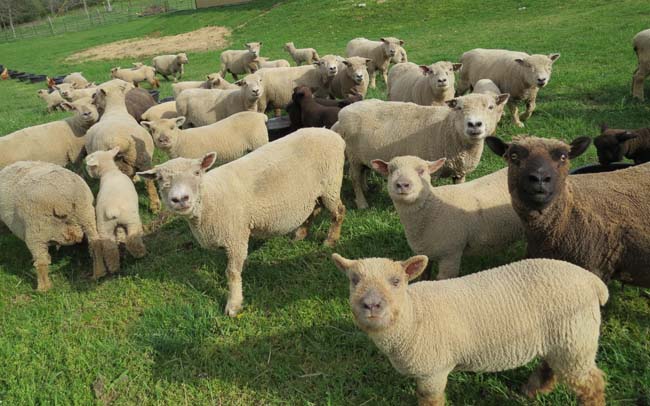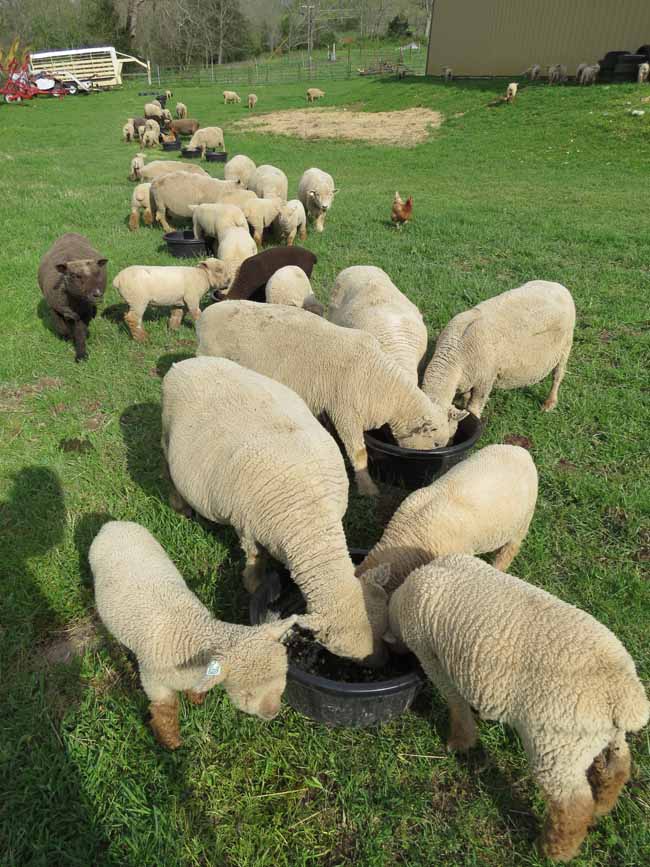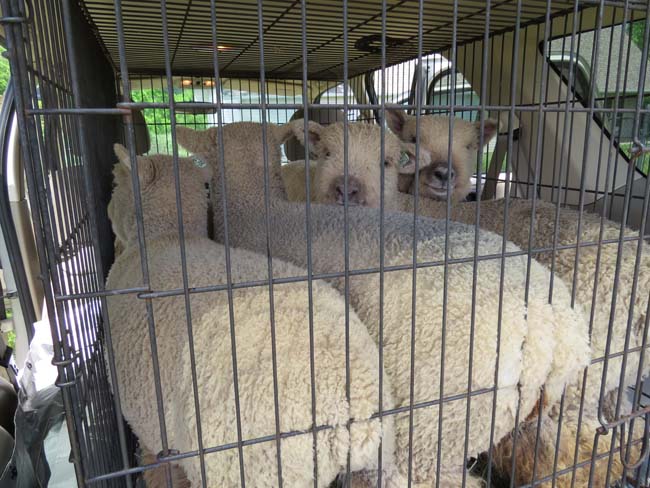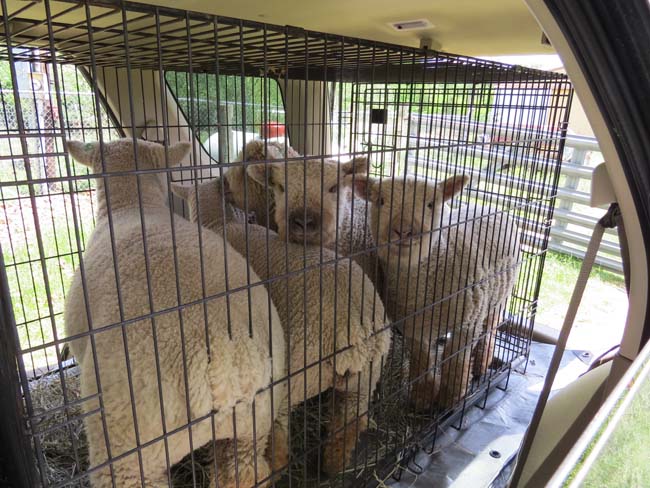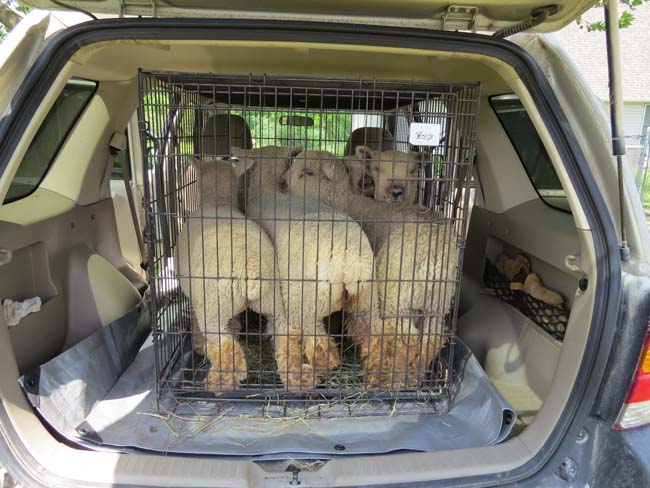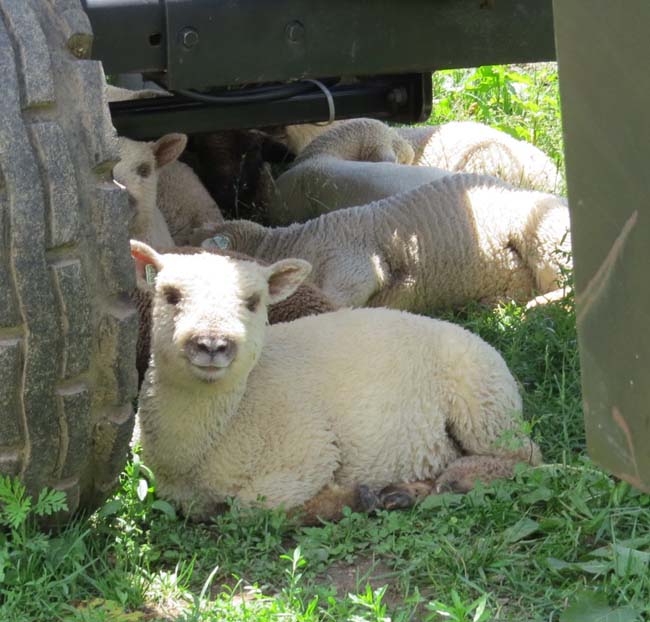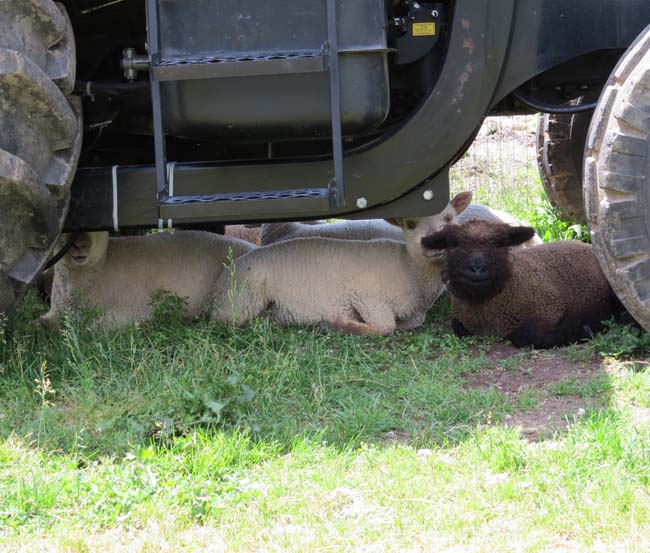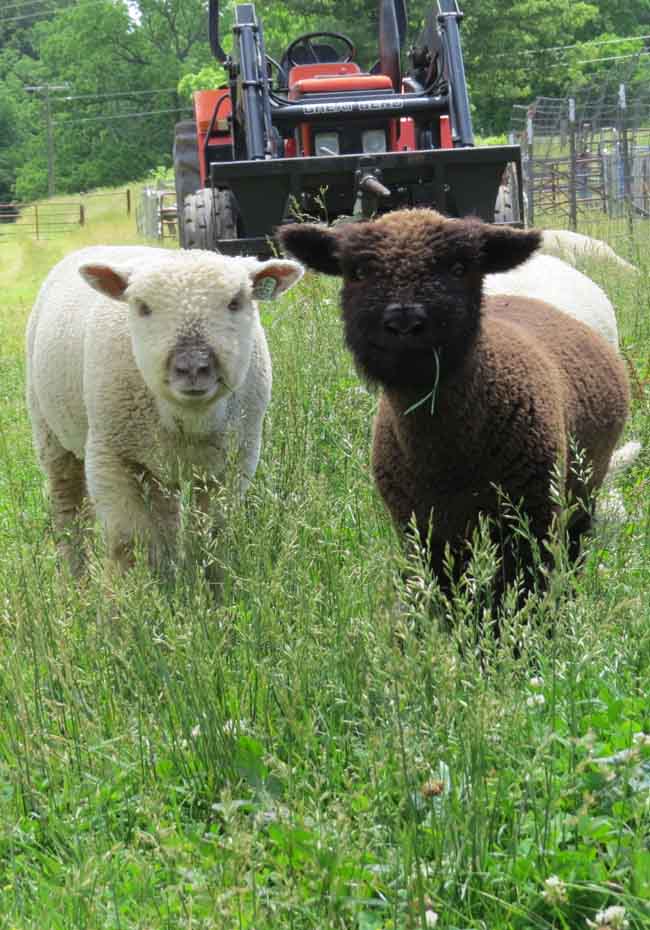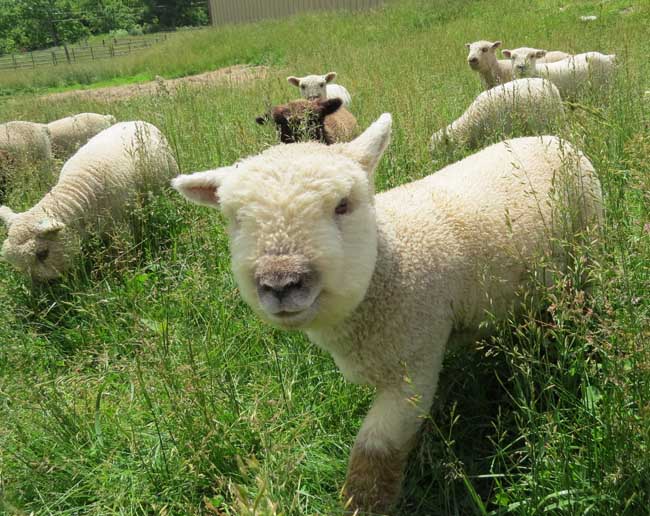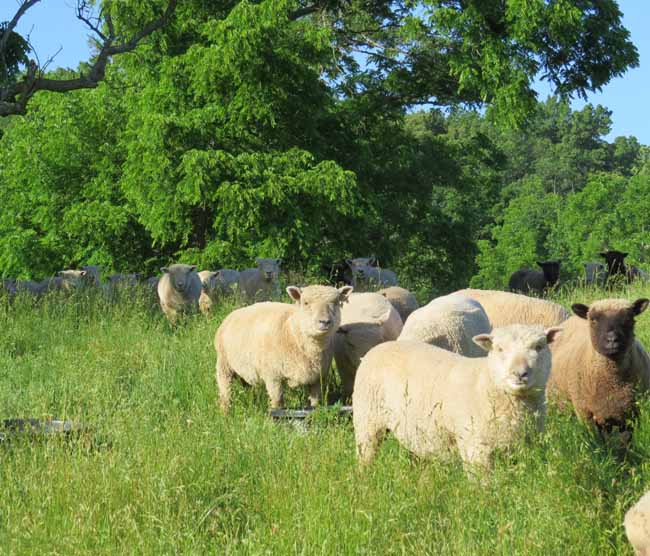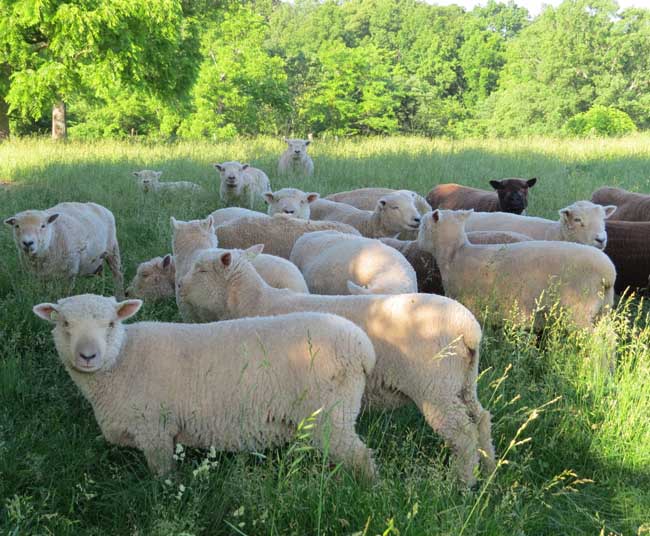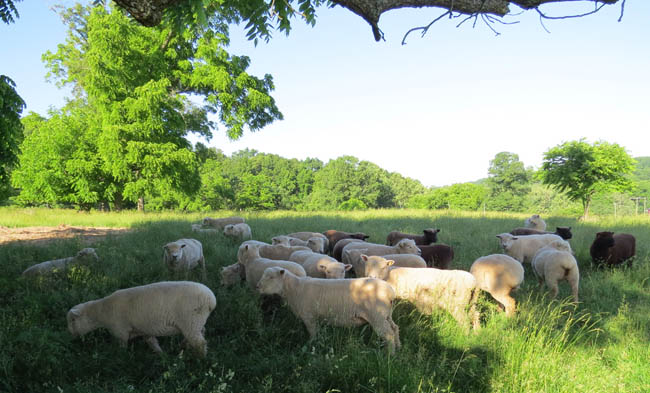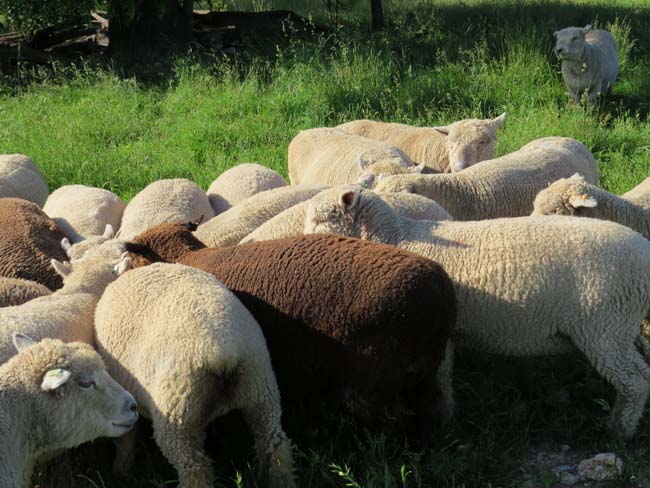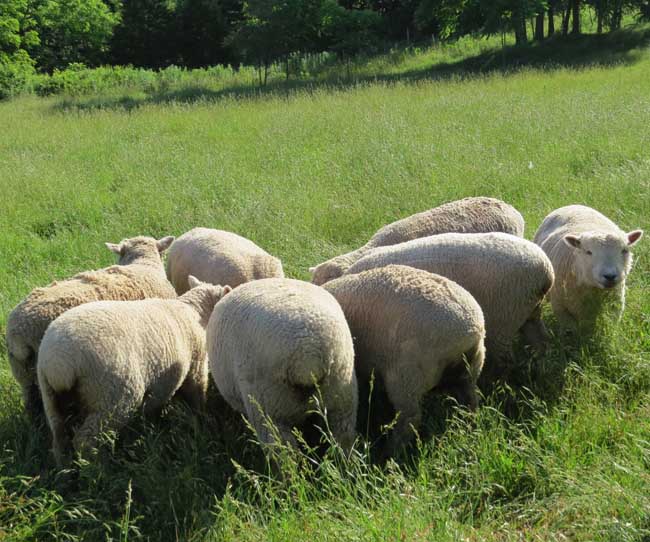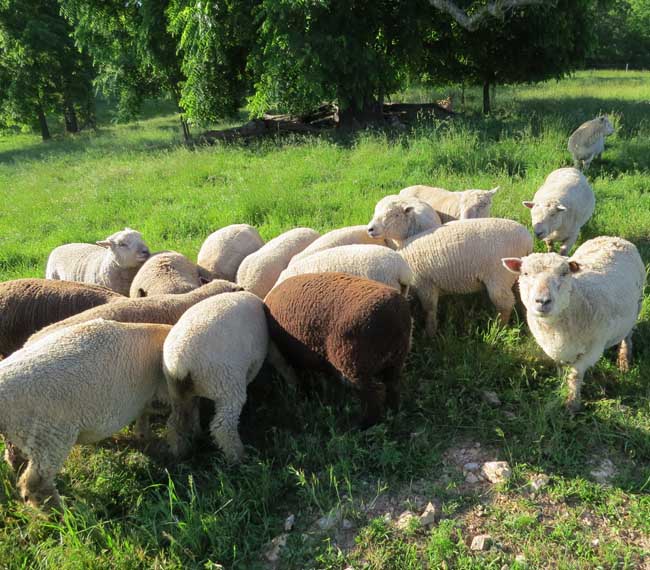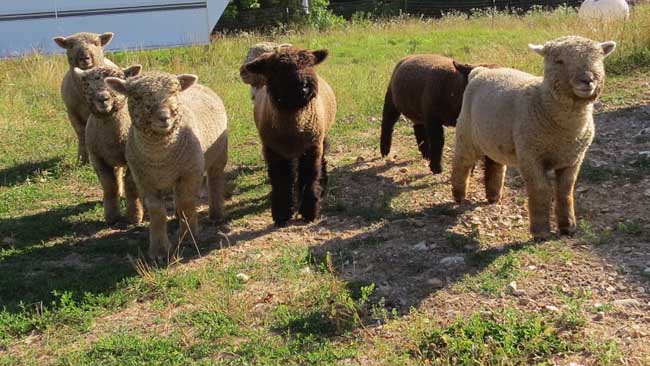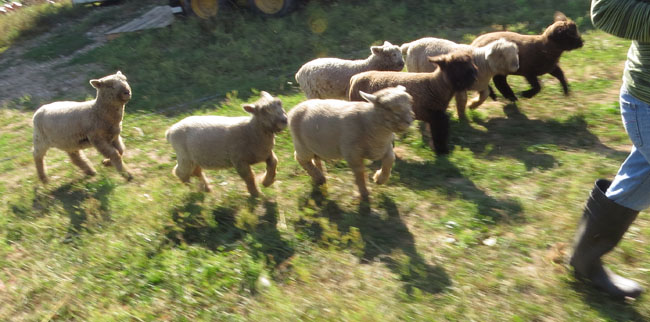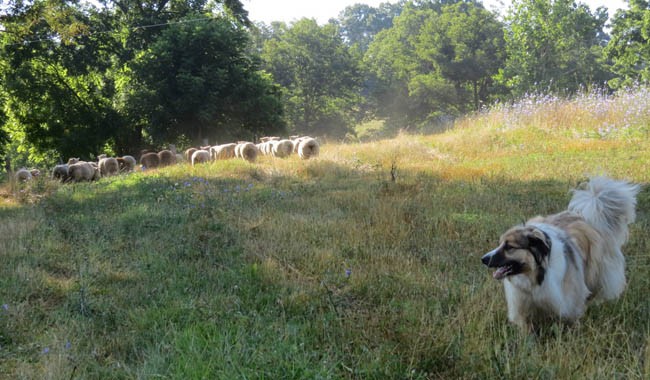- Have you ever wondered what lambing season would be like?
- Are you new to sheep and wondering what you should be doing to prepare?
- Have you already had your own lambs born, but wondered how another person manages their flock?
- Do you wonder about how some of the procedures are done?
Well, come along and “work” at my side! Prepare for long hours, dirty work, and maybe even some sad experiences along the way. But I can assure you, we’ll also have many experiences to smile about as we reminisce later over a cup of coffee.
(Although I will be adding to this journal regularly, it is not formatted like a blog. It will read like an old-fashioned journal, so you’ll need to scroll to the bottom for the most recent entry. Also, refreshing the page will help if all the pictures don’t load the first time.)
First, let me introduce you to our ewes:
Most, but not all, are in this picture. We’ll have 27 ewes that may have lambs this year. Two of them are almost 2 years old and will be lambing for the first time. We’ll be watching those two especially close!
Although the pregnant ewes will be our primary focus, we’ll also be caring for two other groups of sheep. One group are yearling lambs–12 ewes, and also 3 wethers (neutered males). I decided to keep the wethers at least until after they were sheared the first time because they had such nice wool:
We’ll also be caring for 8 rams:
The rams are easy-keepers this time of year….content as long as they have plenty of food!
I should mention a few of the other animals that will accompany much of our work. Heidi, the Great Pyrenees dog (on the left) currently lives with the yearling sheep. Ginger, the English Shepherd (on the right) is my buddy, “helps” with the chores, and thinks sheep noses all need to be licked! One of her “jobs” is to play with Heidi every day–the one time Heidi acts like a puppy. She is very, very serious about her duties the rest of the time.
We will also see a lot of this kitty, who lives in the sheep barn. The sheep love to stalk her, and she loves to tease them by slinking under their bellies:
My daughter (and partner in the flock & fiber projects) will also be working with us a lot. She is great with animals and I’m sure you’ll quickly learn to appreciate her help as much as I have.
So….are you sure you want this job? Really sure?
OK then, let’s get started!
One month before lambing starts:
The earliest lambs may arrive on March 7th this year. I know this because the rams were put with the ewes on October 15th and these sheep typically have a 145 day gestation period. Because it is good to keep the ewes as stress-free as possible once they’ve been bred, they haven’t been worked (hooves trimmed, etc.) since they were put with the rams. During the winter, I simply check on them a lot, trying to anticipate any needs they may have. But it has been a rather uneventful winter….the best kind!
Around the 1st of February, I started feeding the ewes a grain mixture. (Before this, they’ve been on pasture or hay.) It only takes one day for them to learn that routine, and start calling as soon as they see me. At first, they would run down the hill and walk me back up to where I feed them. Now that it is the end of February, they are starting to waddle and moving much slower. Instead, they wait for me near their pans, calling to make sure I don’t get lost on the way.
My grain mixture is 1/3 of each of the following:
- Country Lane – 16% Lamb & Kid Pellets (purchased at Orscheln).
- Country Lane – Cleaned Whole Corn (also from Orscheln).
- Dehy Alfalfa Mills – 17% Green Dehydrated Alfalfa Pellets (purchased at a local feed store).
When switching the diet for a sheep, it is VERY important to do it gradually, giving time for their rumens to adjust. So at the beginning of February, I was feeding a cup or less of this grain mixture per ewe. Now I’ve figured they are getting approximately 8 oz. of grain per ewe each day.
“How do I know how much to give?” Actually I “score” them. That means I feel their spine just in front of their hip area, and then I feel the flesh on both sides of it. If I can’t feel the spine, they are too fat. If I feel the spine and the flesh is lower on both sides, the ewe is too thin. If I can feel the spine and the flesh is even with it, the ewe is in good shape. When they are in full fleece, as they are now, it is important to get your fingers through the wool to feel their body. Being in full fleece and pregnant can make them look fat even when very thin!
“What if she’s too fat?” Then she simply stays too fat and we increase her grain anyway. During late pregnancy is a terrible time to put a ewe on a diet. Her lambs are taking up an increasing amount of space, and most of the growth in the lamb or lambs happens during the last month, including bone growth which requires calcium. If she doesn’t get increased nutrition, her own body may become depleted and spiral her into sickness and death along with her lambs–even if she was too fat to begin with! But having her too fat will increase the risk for birthing problems–lambs that are too large, or weakness during delivery (due to not enough regular exercise). So with ewes, being too fat is not being overly-healthy!
“What if they are too thin?” We’ll keep increasing the daily portion of grain.
“What if there are some that are too fat and some that are too thin?” Ahhh…great question! In my situation, I adjust the grain for the majority of the flock, and watch those on either end closely for any sign of a problem. Fortunately, most of mine seem to maintain similarly. Any that are overweight tend to be a little overweight year-round. I figure it is just their body type, more than feeding differences. If one ewe is suddenly underweight, I’d be concerned some other health problem may be going on and start looking for other reasons.
Although books will often recommend a certain amount of grain for a ewe to be fed, I’ve found it is often high for my flock. It is better to keep “scoring” them, and adjust the amount of grain given accordingly. Babydoll Southdowns are known for being great converters of feed to meat, and they certainly are!
Around the first of February, I also put out some special mineral tubs for the ewes, and will keep providing them until all the lambs are born. When those tubs are emptied, they become my feed pans for the grain. (You will see a lot of “recycling” going on around the farm!)
As throughout the rest of the year, all the sheep continue to get loose mineral salt:
I put out a little whenever they’ve depleted what they have had. That seems the best way to not waste it, and they always have some available.
All the sheep also get fresh water each day. This year I’ve been putting a cup of apple cider vinegar in each pan of water the ewes are provided. There is a lot of speculation about its many perceived benefits, but simply put…it is good for them!
2 to 3 weeks before lambing starts:
Between 2 and 3 weeks before lambing is to start, we give the ewes their yearly CD&T vaccinations. The reason is that by timing it this way, the effect of the vaccination will peak during the time the lambs are nursing. The antibodies provided through their mother’s milk will help cover them until their own immune systems become mature enough to respond to their own CD&T vaccinations. The “T” part of the CD&T vaccination is for tetanus. We’ll be banding tails during their first week, so coverage for tetanus will be very important.
So the “hands off” period of time is over for the ewes, but I still want to keep their stress level low.
“How can their stess level be kept low?” We move them into the barn, then move some into a smaller pen until it is almost full. We want room to work, but not enough room for them to be able to run away easily. Then we get in, moving and talking calmly. We choose the most skittish ewe of the group to work on first, while the others watch intently. By doing the most excitable one first, she won’t get the others worked up also.
Since we are doing both dirty work (trimming hooves) and work that needs to be clean (giving the vaccinations), my husband and son help today. They are trimming the hooves.
“What is needed to trim hooves?” I like a small hoof trimmer. It is especially better when trimming the hooves on the lambs. Shown here is a hoof pick, which can also be nice but not necessary (I typically use my trimmer to flick out dirt from the hooves). Also pictured is a blunt child-sized scissors, which I use to trim around the eyes of a couple of my sheep that sometimes have too much wool grow around them to see well. The plastic bin is very useful! It can straddle the top of a fence or panel to hold things while we work.
“Don’t they need to be flipped to trim their hooves?” No, one person stands with the ewe’s neck in a hold between his legs, while the other straddles her hips to keep her from moving side to side as he trims her back hooves (both facing toward the rear of the sheep). The ewe gets to remain standing in a comfortable position this way, and we are able to avoid putting pressure on her mid-section. When the back feet are done, the person at the front trims her front hooves. This gives each person time to stand up straight in between–appreciated when working with such short animals! Then I give the CD&T vaccination. It is given sub-q (subcutaneous), and there is an ideal spot just behind the front leg that remains wool-free. To give a sub-q injection, the skin is lifted up from the underlying muscle, and the fluid is delivered into the space between (just under the skin).
“Is a separate needle and syringe needed for each sheep?” To keep the vaccinations as clean as possible for each sheep, I wipe off the vaccination bottle with alcohol, then put in the needle attached to the 3cc syringe. But after drawing up the fluid, I don’t remove the needle. I detach it from the syringe, leaving the needle in the bottle. By doing it this way, the vaccination fluid stays as sterile as possible. Then the syringe is attached to another needle which will be used for the injection. This needle can be wiped with alcohol in between sheep and I use it for several sheep before replacing it. When I sense the the needle used for the injections is not entering the sheep easily (usually they don’t react at all if the needle is sharp), I change it to a new one. So, what is needed:
- one needle for the bottle
- several needles for the injections (I use 20 gauge/1 inch long. They are thinner than the typical 18 gauge.)
- one 3cc syringe
- alcohol prep/wipes
- the CD&T vaccination bottle
Afterward, my daughter and I trimmed the hooves on the yearling lambs. We plan to give them their yearly CD&T vaccinations a little later this spring.
One week before lambing starts:
The shearer will be here tomorrow. Wouldn’t you know it….we are starting to get winter weather, finally. It has been a mild winter until now.
We’ve moved a hay bale very close to the barn for the ewes so they can stay warmer once their coats are removed. The rams should be fine since their shelter is small and when they are all inside, they can heat it up easily.
This evening, we moved the rams into the barn to trim their hooves and give their yearly CD&T vaccinations. Here are some pictures of that. It is the same way the ewes were handled earlier:
As you can see, they like to give each other moral support!
Although I didn’t get a picture of me giving the CD&T vaccinations (hard to do both at the same time), here is the injection site (the place without wool, just behind the front leg):
The rams were put in a pen under the shed part of the barn for the night. It is very important to keep their fleeces dry tonight.
The two groups of ewes (and the wethers) were also put in the barn for the night but kept separate. We plan to have the rams sheared first and put back in their pasture, then the pregnant ewes so they can get back to their regular routine, then the yearling sheep. The yearlings will be moved in the morning to an outdoor pen to wait until we’re ready for them (unless it is snowing or raining). We need to juggle the groups, since our barn will also be used for the actual shearing and it isn’t very large.
Some shearers don’t like the sheep to eat in the hours before being shorn. Our shearer doesn’t mind, so we keep the sheep supplied with hay and water. He will be here early, and it will be a LONG day, so make sure you get rested tonight!
![]()
Shearing Day started well before Larry Englund, the shearer, arrived at 8:30. After the routine chores, we moved the young ewes and wethers to an outside pen. Here is your last glimpse of them (still in the barn) before their coats are removed:
Then we cleaned that area for shearing. Our “skirting table” was set up (did I mention we improvise and recycle a lot?). It is a section of hog panel with some plastic chicken fencing over it, sitting on an old sawhorse. Hey…it works!
The pregnant ewes wait patiently, watching us work:
Once the shearer arrives and gets set up, the rams brought in one by one to be sheared first. Once done, they can be put back in their pasture and out of the way as we work with the larger groups. This ram is the first sheep of the day:
He is one of the few sheep that has very short wool. I send only the wool that is at least 2 inches long to the mill, so his wool will be used as mulch.
As the day progresses, one by one the sheep give up their coats. They seem to enjoy the new more weightless feeling. Some of the yearlings start running around the pasture, kicking up their heels like they did as lambs. Others seem confused by suddenly being among a flock of “strangers”. These two yearlings are tentatively introducing themselves, not realizing they are already old friends:
My daughter and I work to move each newly shorn sheep out the door, then take the fleece to the skirting table where we remove the dirty edges, areas with too much hay (vegetable matter), and any areas with short fiber. Then we shake the fleece and remove more vegetable matter by hand. We also record the length of the fiber for our records about each sheep. When the holding area gets empty, we move in the next group of sheep. Larry does the Real Work, moving out each sheep from the pen and shearing it. My husband and son take “shifts” sweeping off his work area between sheep, and taking the bins with fleece to our garage where they will be packed for shipping later.
At the end of the long day, we have 50 very bare sheep. Hey…no peeking! 🙂
We ended up with 135 lbs. of good quality wool which will be packaged and sent to the mill to be processed. (We can expect to get about half that weight back.) I’ve learned this is too much wool for me to hand-process myself, so I have them do the washing and carding, leaving me more time for the activities I like better, such as spinning.
A few days later, the wool waits in boxes to leave for its journey to the mill:
So, do the sheep stay warm with the temps hovering around freezing? After shearing, we leave the barn door open so they can get warm anytime they wish. At night, we also turn on the light since they usually like to sleep where there is light available. They’ve chosen to sleep in the barn at night, but the rest of the day they continue to stay outside. I haven’t even seen one shiver after the first hour of two following shearing!
One day before lambing starts:
Today we moved the pregnant ewes to the smaller pasture by the barn. This will make it easier for us to move a ewe and her lambs into the barn if she delivers them outside. Our weather is starting to warm up, and we are grateful for that! Ideally, we’d like for the ewes to deliver outside to keep things as natural as possible until the lambs are up and walking. But at night, we’ll bring all the ewes into the barn so we can check on them regularly.
After cleaning the barn, we set up some of the “lambing jugs”. That is a term used for the small pens where a ewe and her lambs will be kept for several days. This allows them time to get to know each other without interference from other sheep, and allows us to make sure the little family is doing well.
For lambing jugs, we use hog panels, both full length and some cut shorter. Hog panels work well with lambs since the spaces are very small at the bottom. You’ll see pictures of those pens later as they are being used with the sheep.
Next, I get my “lambing bag” ready, which I’ll be taking to the barn with me every time I check on the ewes.
The most important item to me are the old clean towels. Hand towels and washcloths are my favorites since they are smaller, but I like to keep at least one bath towel in the bag too. Those are great to quickly wrap a lamb in to keep warm while transporting. Lambs can be VERY slippery!
We have a mesh bag to put dirty towels in, to bring back to the house.
Items from left to right are:
- Nutri-Drench – We’ll be giving each lamb 4 ml. of this soon after birth, for a little boost of energy and vitamins. This can come with a pump on the bottle, but I’ve found that tends to leak and it’s harder to judge the amount given. This year we’ll draw it up with a syringe (without the needle) to deliver it.
- Gel hand sanitizer – used on my hands first if I need to assist with lambing.
- SuperLube – a very slick antiseptic lubricant used on my hands next, in case I need to assist. (The label is stained from some Betadine that leaked on it last year.)
- Syringe – to draw up and deliver the Nutri-Drench.
- Betadine – I have a big jug of this to fill this spray bottle that was bought at WalMart.
- Scissors – a scissors is just a handy item to have around, so I include it.
- Another syringe, in case the first gets dirty.
- Bulb Aspirator – I think I got this one from an ear wax kit. Sometimes it is helpful to aspirate fluid from the nose of a lamb. (The tip is stained from that leaky Betadine too.)
The two plastic bags with zippers probably packaged curtains or pillowcases originally. Did I mention we recycle…..oh, I guess I did. 🙂 I keep the leakable things in one plastic bag and the dry ones in the other. The towels go in the “lambing bag” first, and then the two plastic bags sit on each side able to be opened from the top.
I have other lambing supplies kept inside the house that I’ll mention later.
Next we’ll trim our fingernails very short, and remove our rings, any watches, etc. Plan to dress in layers and for warmth. A “quick trip” to the barn often turns into hours, and sometimes there just isn’t any good time to get back to the house for warmer clothes. If you haven’t already discovered “mud boots”, be warned….you may soon learn they are your favorite footwear! Being able to slip them on and off quickly becomes rather important after the 10th trip to the barn that day. And here’s a little secret: chunky handknit Babydoll Southdown wool socks inside mud boots are warmer than most fancy insulated boots!
Well, do you think we’re ready for the lambs to start arriving? I guess we’ll soon find out.
At 4:30 am, the first lambs arrived…a ram first. Then as his mother was licking him off in a standing position, a ewe suddenly arrived landing on her head! What an introduction! We thought the drama was over, but then the ewe glanced away from her lambs as if looking for a place to go–a huge clue that another is about to arrive. Sure enough, soon another ewe showed her face. This time I was able to catch the teensy tiny lamb.
Elyse, the mother, is a very easy ewe to work with and a good mother. It was surprising she stood during the delivery of her last two lambs, but surprising things happen rather frequently. This is why I like to be present for all deliveries. Another surprise was that Elyse had triplets. She has had a single and a set of twins so far. Her parents were both twins, and Elyse was a twin.
Do all your sheep have names? Yes, and their own personalities too!
With 27 ewes in the barn, how did you know THIS ewe was about to lamb? Well, in some ways it goes back to knowing their personalities. She just didn’t seem to be herself yesterday. She was still doing everything all the other sheep were doing, but just seemed more in her own world…distant at times. That is a sign a ewe may be having contractions, and that can happen for many hours before birth. Her udder looked full (although that is not always a reliable indicator) and her vulva looked more pink and puffy.
Just prior to delivery, she was standing with a very far-away look to her eyes, ears back. She looked sunken in just in front of her hip bones (a sign the lambs are getting in position). She’d paw at the ground, and then laid down, then got up and down a few more times. Each time she would rise up, she’d turn and smell the ground that had been directly behind her. Finally, she laid on her side, and obviously started pushing, extending her upper back leg out straight as she strained. When we see that, we know a lamb is arriving very soon.
What do you do then? Well, we had already put this ewe in a pen by herself. We scattered some hay over the dirt so the arriving lambs wouldn’t become dirty. Then we waited outside the pen until we saw her actively pushing. I put my “lambing bag” where I could reach it, and made sure I was ready with a towel. As the lamb appeared, I made sure it was in proper position.
What is proper position? A nose with at least one foot also present, and the two toes pointing up. Lambs should arrive as if they are going to leap out into a standing position.
If you don’t see a head, how do you know if the lamb is backwards, or if the head is turned back? There is great clue…look at the ewe. Do you see how both of the front lower leg joints bend the same way? Now look at her back legs, do you see how the lower joint bends like the front leg, but the joint above that bends the opposite way? By figuring out how that higher joint bends, you can know whether it is a front or back leg. Also, most (but not all) backward lambs will arrive with their backbone up, so their toes will be pointing to the ground rather than the sky. Most lambs will arrive in either the correct position or backwards. The main thing to remember about a backward delivery, is that when the lamb’s umbilical cord passes through the pelvic bone of the ewe, the cord will be constricted. The lamb’s response may be to take a breath then. So be very ready to help the lamb be born quickly once the legs are out. Help woosh it out (gently but with purpose), and immediately get the nose wiped off with the towel so the lamb’s first breath is of air, not fluid.
It seems like there is a lot to think about! Actually I’m very focused on one thing above all else during delivery—getting the airway clear. That means getting any sac or fluid off the nose. I also like to swipe my finger through the mouth of the lamb since that usually causes the lamb to take a deep breath, and opens a second airway (the mouth) that was closed before.
Once the lamb is born, do you dry it off? No, I usually let the ewe do most of that. I try to provide dry hay to lay on, and no draft. The lambs can take quite a bit of cold (like an unheated barn), but moving air is not good.
Do you use a warming box or lamp? No.
Don’t you lose lambs to the cold, or to pneumonia? It hasn’t happened yet.
Do you give any medicine to prevent pneumonia? No.
We’ve gone a long time without a picture. Do you want to see Elyse and her lambs?
The little ram lamb is letting his mom rest her foot on him. The other two are his sisters.
After they are born, what do you do? I give them 3 to 4 ml of Nutri-Drench in their mouth, and spray their umbilical cord with Betadine.
Do you cut it shorter? No. That doesn’t make sense to me. I figure the reason we spray the Betadine is to stop infection from moving up the cord into the lamb before the cord dries up. So why would I make the route for possible infection shorter? Plus, I’ve never had a problem doing it this way. If I ever do, I may change my procedure.
I also check the ewe to make sure she has milk on both sides. There is often a wax plug present that keeps the route to the milk clean until the lambs need it, so “milking” her slightly will remove that. This is done by gently closing two fingers at the top near the udder and using a rolling motion to “milk” down will cause pressure to build above the wax and dislodge it. The first milk is usually very thick and yellowish. This is colostrum, and is incredibly important for the lambs, so don’t “milk” any more than necessary. The colostrum helps pass on the mother’s immunities to the lambs during their first weeks when they have no immune system of their own.
Did these lambs start drinking right away? No. Some lambs just seem more immature at birth. Maybe these were born slightly early since they are triplets? I don’t know. But some lambs just don’t seem to “get it”. They will though. They just need a little extra time.
Do you tube them? No. I only do that as a last resort. I want the lambs to learn to suck from something, even if it is a bottle. It helps teach them what they need to know to drink from their mother. If I tube them and keep their stomachs full, what do they learn? What do they have a chance to learn? My goal is to have their mother raise them. That is much healthier for the lambs. The process of tubing can irritate the throat and/or get milk in the lungs, so I’d prefer to not risk that if possible.
So what do you do? For these, I heated up some raw cow milk and added more cream to it. Then fed it with a bottle to each of them. They all eventually drank some. I will continue to bottle feed them occasionally…enough to keep them increasing with energy, but I want them to get hungry too, so they will focus on their mother. Before bottle feeding them, I will encourage them to nurse from her first.
Did it work? By evening, two lambs are able to nurse from their mother, but the littlest ewe still hasn’t. She is full of energy though, and doing well. I’ll continue until she also learns.
Well, it is time to go do another barn check and feed the littlest lamb. I’ll leave you tonight with a picture taken this afternoon of some ewes enjoying the warm sun.
Today, no more lambs arrived. The smallest lamb continues to be bottle-fed since she still isn’t drinking from her mother. I decided to milk her mom, then bottle-feed her milk to this lamb since otherwise she wouldn’t get any of her colostrum. All three lambs are doing great, and so is their mother. We let them all spend some time outside today while we cleaned their pen and the barn. We did that by carrying out the lambs, and the ewe followed. She enjoyed the grass!
The little ram has a dirty bottom which you can see in this picture (the lamb drinking). When lambs are first born, their first “poo” will be tarry black (meconium). Then as they drink milk, it will turn pasty bright yellow. Later on, they will start forming teensy pellets that are typical for sheep. The thick yellow type can easily cause “pinning” which is a “sheep term” for what it does…pins the tail to the body of the sheep and acts as very tough glue would. This is something we watch them closely for, and clean them with a wet paper towel before it can obstruct. A little trick: we spray cooking oil (100% Canola) under the tail, which helps keep it from sticking. Lambs that lay around a lot and drink the most seem most prone to pinning. (In almost every picture I took of them this day, the ram lamb was busy drinking.)
Back inside, we gave them a larger area since we still have the room. This will let them move around more.
In case you wonder how we clean the barn floor, it is done with a rake. Then we shovel it into a bucket and take it outside. It will later be used as part of a soil mixture for planting grape vines, or to cover grape graft unions for the winter. Sheep manure is a wonderful fertilizer, lightweight, easy to work with, and relatively odorless.
After having tried several systems during lambing season, including the “deep bedding” method (where hay is just added and added on top throughout the season), I’ve come to believe the cleanest and easiest method is to rake daily, and completely clean the pens down to the dirt after each group is moved out or after several days has passed. As with this little family, we sometimes switch them to a new pen. This allows their previous one time to dry and air out after cleaning. The one problem can be the dust. So moving the sheep outside, then opening up all the doors so air blows through freely as we work, helps a lot. Each day that is warm and dry throughout lambing season, we’ll be cleaning!
OK, enough of this “dirty work”. (I did warn you we’d have some, didn’t I?) Let’s go outside and check on the other ewes. It looks like they are all chewing their cuds. That is a sign none are ready to lamb very soon.
Were you wondering about those animals in the background? Those are our Morgan horses. Here’s a closer look for you:
OK, back to the sheep….let’s go check on the rams. Wanna guess what they’re doing? Yup, you guessed it!
Some great news…the littlest lamb is now drinking from her mother! Yay!!!! She is maintaining her weight and competing quite well with her siblings for her share. It will be very important for us to keep supplementing their mother with extra grain so she can keep providing enough milk for all three of them.
Also, during a loud thunderstorm in the middle of Saturday night (even louder since the roof of the barn is metal) we had more lambs born! Twins (male and female) were born to one ewe, and a single male was born to another ewe. The female was in a backwards position, but since I helped assist and get her airway wiped off fast, she did fine.
Our weather has turned cold, rainy, and windy. This increases our chores, and the need to check on the sheep more often when they are in the pasture. I’ll take pictures of the new lambs a little later for you.
As you can see, the pens are starting to fill:
The ewe begging for more grain with her eyes is Elyse. Her triplets are starting to fill out. When the lambs are born, they have lots of wrinkles. But within the first few days, they seem to grow into their skin. As you can see, the lambs are very busy, and like to visit with the other sheep in the neighboring pens. The next lambs to be born were the twins at the top of this picture. They are white although their mother (“Abigail”) is black. Their sire is “Siegfried” (named after the vet in the James Harriot books), a very young white ram who had a black sire. I was hoping his recessive black genes would produce black offspring with this black ewe, but I’m mainly happy they are healthy–no matter what their color. In fact, Siegfried is the sire of all the lambs born so far. He apparently took his job seriously last fall!
This is the second time Abigail has had lambs. Last year she had a single male, and we joked then about her being a “teenage mom”. She had a lot of fun with her lamb…running and playing with him like she was a lamb herself! This year she moves a lot, not standing still for very long to allow her lambs to drink. So we are watching them closely to make sure the lambs get enough. She has a very good supply of milk, if they are able to latch on long enough. Here are her lambs (a male and a female):
As you can see, they still are wrinkled and not filling out much yet. They are quite active though–leaping around their pen, so I believe they are fine so far. These lambs look yellow and that is normal for many lambs right after they are born (birthing fluids cause it). Their fleece will become white over the next few weeks.
Born the same stormy night, at almost the same time, was this big handsome boy:
Singles are usually the largest lambs, and grow the fastest too. He has been the least active of all the lambs born so far. No competition for milk, and a doting mother. Lucy will be very attentive to him!
Another set of lambs was born yesterday afternoon, in between barn checks. This ewe ” Kaatje” has fooled us two other years before! But that is OK…she’s a great mom and apparently has never needed our assistance. Her twins (a male and a female) were standing already when we found them, strong and searching for milk. We checked her milk supply but were only able to get a few drops. So we decide to supplement her lambs until her milk supply increases. I call this “buying time” since it can easily mean the difference between a lamb getting off to a great start instead of struggling, and can actually mean the difference between life and death. A lamb’s first 24 hours are extremely important!
Until noon the next day, we see the lambs regularly trying to nurse, but quiting after a second or two…not enough yet. Then at noon, we see them latching on for longer periods of time, and obviously excited to find milk available! We are happy to see them starting to jump around their pen too.
These mothers are being fed all the hay they want to eat as well as some grain. Lucy, the ewe with the single lamb, gets the least grain. Elyse, the ewe with triplets, gets the most. The ewes paw at the pats of hay, eating the choice parts. The rest becomes bedding and helps keep the pens dry, warm, and fairly clean for each little family.
When the lambs are less than a day old, we give water to the ewe each time we are there, taking it out of the pen afterward. We don’t want a lamb to drown. After the lambs are able to walk around well, we leave the water in the pen, in a very small rubber pan. Due to their size, the pans need to be rinsed out and refilled often (usually around 8 times a day). Fresh and plentiful water is important for adequate milk supply.
Another set of triplets arrived yesterday evening! This time a female and two males were born to Angela. The one male is small, and his siblings are very small:
Again, I’m “buying time”, supplementing them until I’m sure they are all being provided enough milk from their mother. She has enough, but I suspect the smallest male is rather immature yet. Even when I bottle feed him, he tends to work it out of his mouth and isn’t sucking well. He is stretching when he stands up though…a good sign! The two smaller ones continue to look very thin though. Do you see how this lamb’s sides slant inwards toward the back when she is viewed from above?
Compare her with the little ewe from the other set of triplets that I was bottle feeding at the beginning also (picture taken today also):
(Yes, Elyse felt a need to smell the camera.)
It is important not to feed too much at a time though, and like before, I want the lambs to become a bit hungry so they stay interested in their mother’s milk. It is a fine line to walk.
The lambs got their tails banded today, which I typically do during their first week. I wasn’t in a big hurry with the first set of triplets though, since I wanted to make sure they were doing great before stressing them in any way. Banding cuts off the circulation to the end of the tail, and it will simply fall off in a few weeks. They are uncomfortable for a little while, and then get back to playing once it goes numb. In the past, I purchased a few grown sheep that hadn’t been docked. Those experiences convinced me that docking is in the best interest of the sheep.
Here is the banding tool, with an orange band:
The tail would be placed down through the opened band. Then the applicator is allowed to close a little and the band is pushed off the top. Since this makes the band come off a bit higher than it originally was, it is good to really watch placement.
I leave enough of their tails so their “privates” are covered (sunburn can be a problem) and also long enough the muscles attached to the tail are not affected. Do you see the two muscles on each side (pink)? Those muscles are needed! So this is the shortest I would dock. It is believed that docking too short can contribute to prolapse later on in ewes. When left at this length the sheep can wag their tails too.
After a short time, the lambs got back to their normal activities. This little guy seems to enjoy nibbling ears! First his sister’s:
Then his mother’s:
Tomorrow is supposed to be sunny and warmer. Maybe we’ll be able to let the little families outside for a while!
Early this morning another ram lamb arrived, born to Therea. A BIG ram for one of my smaller ewes! They did fine, but she was very tired afterward.
Today is the BIG day! The first day for most of the lambs to see the world outside their pen. To keep track of which lamb belongs to which ewe, we put their eartags in first. These are the official “scapie tags” required for all sheep that travel away from the farm where they are born. Although very large ones are furnished for free by the government, I choose to purchase smaller ones that are also acceptable. These don’t weigh the ears down as much (we don’t want one droopy ear, do we?) and they also don’t get caught on things as easily.
The ears of the lambs have ridges. The tag should be placed between ridges, where the tissue is thinner. This avoids blood vessels. I like to place them close to the lamb’s head, which also helps to keep it from getting caught on things or weighing the ear down. Since Therea’s ram was so big, I decided to give him an eartag today too. (With smaller lambs, I usually wait until they are a few days old.) These pictures are of him, so you’ll see some birthing fluids still on him. This is the inside of his ear. Do you see the ridges and how the tag was placed between them and close to his head?
My daughter holds each lamb, and uses her hand to hold the head against her body so they can’t jerk and tear an ear in the process. At this age, most don’t hardly flinch, and any discomfort is over immediately. By putting tags in the right ear on the females, and in the left ear on the males, it is easy to tell them apart from the front or at a distance…even when many of the males become wethers (neutered males) later. Although the tags look large now, they will become very inconspicuous when these lambs become adults.
We’re leaving the newest triplets, and this newborn lamb inside. All the others get to go on a big adventure!
Here are Kaatje and her two lambs…including the little guy with the “thing” for ears! (Elyse and her triplets are in the background.)
Elyse with her triplets who are already interested in the grass:
Lucy and her lamb get a lot of attention from the yearling ewes on the other side of the fence:
(This picture shows the size difference between a yearling ewe and one that is older. This difference in size is why I don’t allow my yearling ewes to lamb their first year.)
Abigail’s twins quickly decide it is time for a nap:
Then Kaatje’s twins fall asleep:
But Elyse’s triplets are still having a blast! Being even a few days older really makes a difference!
By the way, the little gal that is pushing her sister, is the smallest ewe that I originally bottle fed. She is still so teensy I decided to wait on her eartag a bit longer. She certainly has become a spunky little lamb!
Well, it’s been fun watching the lambs…but we need to get busy cleaning out those pens!
Once the ewes and lambs seemed to be doing well at staying together, and finding each other once again when lost, they experienced a bigger adventure…the barnyard. This area is much larger and has the barn in the middle, so it is easier for them to lose each other. But they did great! Ginger accompanied me while I took these pictures, and although she would have loved to greet each lamb with a kiss on the nose, she stayed at a polite distance so the mothers wouldn’t worry.
Mmmmm…smelling something good!
Ginger decides to try moving in a little closer, which is tolerated fairly well by most of the ewes…
…until she comes too close to Lucy’s lamb. Lucy stomps her foot, threatening to charge at Ginger:
Although Ginger thinks that having Lucy chase her would be a fun game, Lucy is not amused. So I ask Ginger to stop worrying her, and we move away.
Do these pictures look like Spring has arrived? Well, this is Missouri, so of course the weather needs to change soon, doesn’t it?
Now that Spring has “officially arrived”, winter weather has finally moved in! Lots of snow with bone-chilling winds and temperatures hit with a blast…and linger. As soon as the snow storms started, the second wave of lambs began arriving. All of the expecting ewes, ewes with lambs, and the ewes with their newborns in the individual pens needed to stay inside. Talk about a full barn!!! Pregnant ewes cannot be mixed with lambs, since the lambs may take the opportunity to steal milk (the precious colostrum their own lambs will need later). So the logistics of providing hay, water, adequate room to move around, as well as trying to keep everything as clean as possible (and not open the door too much, letting in a cold blast) takes over our lives. My daughter and I practically live in the barn, making quick trips to the house for bottles of milk, more towels, etc. At one point I figured that out of the past 90 hours, I’d only spent 10 of them in my bed, although even then sleep didn’t come easily. Have you ever been so sleepy, it becomes hard to sleep? And any dreams are of sheep, of course.
But it is all worth it, isn’t it? Here are our new arrivals (the pictures were taken a few days later when I got the time):
Kenzi had twins at 9:30pm on March 21st. A ewe and a ram. These are the first lambs with Edgar as their sire.
Sundae had twins at 7am on March 22nd. A ewe and a ram. Their sire is Siegfried.
Tulip had triplets at 9pm later the same day, and they were the first black lambs born this year. They were a ewe, and two rams. Valentino was their sire. All the lambs were very small. The ewe lamb seemed to have something wrong neurologically (maybe from oxygen deprivation at some point?). She would lay on her side and kick her legs like she was running. We kept her fed with a bottle but she died the next day, so this was the first sad experience this lambing season.
Sophie had twins at 4am on the 24th. A ewe and a ram lamb. Edgar is their sire. (Sophie’s lambs are the two whiter ones in this picture. I’ll tell about the “yellow” one next.)
Amie had been acting all night like something was wrong. She’d look like she was having contractions, but not pushing as a ewe would normally. She just laid around looking very weak with no interest in food. So around 8:45am I decided it was time to check inside to see what the problem was. Sure enough, I felt a lamb’s rump with the back legs also forward. So I worked my fingers around the side of the lamb until I could feel a leg…and then a hoof. Cupping the hoof inside my fingers so it wouldn’t scrape the mother, it was extended to the back. Then I carefully fished for the other leg and hoof. Once they were in the proper position for a backwards delivery (back feet coming first), the lamb practically shot out, followed very quickly by two other lambs. So Amie had a ewe and two ram lambs, with Valentino as their sire. She was so tired though, and shivering, that I wasn’t confident she’d be able to take care of them. She also didn’t have any milk, which is common for the first day or so with a difficult delivery. So when Sofie and Amie’s one ram lamb started talking back and forth to each other, I decided to see if Sophie would adopt him. She did! Sophie has raised triplets before, so I knew she could already “count to three”. Sophie licked him dry quickly and seemed quite pleased with “her” new lamb. He is the “yellow” lamb in the above picture. This next picture is of Amie and her ewe lamb a few days later:
At 10:30 the same morning, Scarlet had a single white ewe lamb with Valentino as her sire.
I decided to “push my luck” and see if Scarlet would also adopt one of Amie’s lambs. All went well until a couple hours later, when Scarlet suddenly decided she had an imposter in her pen. So after a head nudge from Scarlet to push the lamb away, Amie’s ewe was returned to her pen and I started bottle feeding her as well as the other ram lamb still with Amie. That ram was the lamb that had obstructed their delivery, and he was also the smallest of the three. He was extremely weak from the start and had little ability to drink, even from a bottle. I figured he probably had his oxygen supply pinched or torn during the delivery process. I kept taking the time to make sure he had enough milk, and also made a little wool jacket out of a sock to help him stay warm, but kept wondering what his prognosis would be.
At 1pm that same day (March 24th) Lilac had white triplets; one ram and two ewe lambs, with Valentino as the sire. One of the ewe lambs is the smallest lamb I’ve ever seen! I decided to bottle feed her for at least a while, since she wouldn’t have a chance at competing for milk with her two larger siblings. I also made her a little wool jacket to wear from an old sock that had felted.
For much of the day, Dandelion was having contractions but not wanting to push, and had been acting ill like Amie had. I suspected the same problem–a lamb stuck. So at 11pm I decided to check inside, and sure enough–a lamb’s rump was blocking the way. A ewe and a ram were soon delivered, but were very, very small, weak, and seemed to be premature. I worked with them, trying to get them to drink from a bottle (Dandelion didn’t have milk) but neither would try to suck although I was able to get them to swallow some of the warm milk. I dried them off and gave them jackets, but both died a few hours later. Then Dandelion passed a small fetus that had been dead for some time. I had to wonder if the other lambs had been poisoned or become affected by this one? Poor Dandelion….no wonder she felt bad! We’ll be working with her to get her strength back, and watching to make sure she has no signs of an infection or other problem develop.
The next day, Daffney had a large white ewe lamb born at 10am. Her sire is Siegfried. They are doing great!
That same day Amie’s little ram lamb that was continuing to live with her, stopped drinking from the bottle. He’d always needed me to take my time and patiently work with him since he was very slow and weak, but it seemed that he decided to give up entirely. I also noticed that his respirations were faster and he was sleeping more and more. He died during the night.
Deaths like these are always sad. Being a small triplet and starting out life with a difficult delivery during stormy winter weather, sure stacks the odds against life. I’ve learned it is good to be philosophical and think about the span of a sheep’s life, how many sheep we have, and how many lambs are born that are lively and healthy. At this stage of our lambing season, we’ve had 15 ewes deliver and there are now 27 lambs that seem to be doing well, so our lambing/survival rate so far is 180%. That is good, so I need to focus on being very thankful for it! I also need to remember that although I do what I can to determine the destiny of each one, ultimately I am not in control. So it is wise to do my best as though I can determine the outcome, yet be resigned to accept whatever happens, and then get busy with the next task that needs to be done.
So let’s get back to work. All the ewes need hay and water again.
Until the winter weather moves on, all the sheep are kept in the barn as much as possible. Even the pregnant ewes who could be outside need to return to shelter frequently, and we can’t leave the barn door open with all the little babies inside that can chill easily. So we go to the “deep bedding method”, simply feeding hay that also becomes a bedding layer that grows and grows. The environment stays clean and it is also warmer.
Once we finally get warmer weather, we let them outside again and start cleaning the thick layer out. The longer it is left, the harder it is to clean up so we don’t want to procrastinate! My daughter has volunteered to carry it outside to the “compost pile” if we’ll fill the containers. Eventually the used hay/manure mixture will be used in the vineyard or a garden to help enrich the soil. So would you like to use a pitchfork and remove the hay, or a rake to clean up what is left?
Whew! Well isn’t that a great feeling to have the barn clean again?
The newer lambs are “graduated” from their pens, and are now our second Ewe/Lamb group. It would be too confusing for them to be put with the older lambs that are now spending much of their time racing around the barnyard as a stampeding flock of their own. Of course, we’ve also banded their tails and given them eartags first.
Our new arrivals have been Rebecca’s twin rams born on March 27th…one black and one white. They are doing great, and have Huldrych (a white ram) as their sire:
On the 29th, Skyla had black twins. They are a ewe and a ram, and both are doing fine. Their sire is Donker, a black ram.
You may have been wondering about how Dandelion, the ewe that lost her lambs, is doing. She took a couple days to pass her afterbirth, and I don’t think it all got passed. She continued to push (as if giving birth) and generally seemed very weak and like she felt sick. She wouldn’t eat much, but was eating a little. I started making up Bounce Back (an electrolyte solution) and fed it to her using a large syringe, a little at a time. This is the first thing I tend to reach for if I have a sheep with a problem. It gives them energy and there is usually a noticeable improvement shortly after they are fed it.
I decided to call our vet to see if there was anything else I should be doing, and was told to just give her Penicillin to offset any infection that might start. The vet believed it is best to let her attempt to pass on her own whatever is left. Dandelion is steadily gaining strength and her appetite has impoved a lot. I have her living with the pregnant ewes again, and am keeping a close eye on her.
Would you like to see a “classic” Babydoll birth? Are you sure? You won’t faint on me will you? 🙂
Clover has volunteered to have her delivery photographed on a day with good lighting in the barn. She came inside from the pasture and started hanging out in a corner. Pippi, a two year old ewe that is just a pest to the other ewes much of the time (playing instead of taking impending motherhood seriously…perhaps she isn’t even pregnant?), joined her and Clover became indignant and ran her off. Then Clover started laying down and standing up. She was searching with her nose to the dirt as if looking for something. Then she’d lay down again, and soon stand up. But she was sticking to her spot. So I knew she was volunteering for the photographic documentary….and moved her into a pen.
Before we go on, some of the other significant signs that the time has come for her:
She had a sunken in appearance just in front of and near the top of her hip area (black arrow), and also on either side of her back spine and tail bone area (blue arrow). This is caused by the muscles relaxing to allow the lamb to come through, and also the lamb getting into position:
The udder will look very full (regardless of its size) and her teats will stick straight out from it, appearing full. Her vulva will look puffy and very pink.
Clover lays down and stands up many times in the pen. Her breathing is labored and she grunts at times. Eventually, she starts really pushing, working hard. Eventually, a shiny bag appears:
Then another bag (the number varies):
Then we see something other than fluid in the bags. A lamb!
This is when it is good to check on the position of the lamb. There should be a nose/mouth at the top and two feet underneath. One foot is even fine. The hooves should be positioned as if the lamb is ready to jump out (if the ewe were standing). Once you become familiar with this, you can check by feeling only, within a couple seconds. (This lets me know if I should sit back and relax, or get involved.)
It is much harder to check on the lamb’s position by sight…especially in a dark barn! So close your eyes and “see” with your fingers as my daughter is doing:
This is the perfect position. The lamb’s head is on top (to the right in this picture), with both feet underneath. The pink you see is the lamb’s tongue which is hanging out of its mouth (which is common).
If this were a very large lamb, and it seemed like the lamb was stuck, a leg could be extended by pulling on it with firm yet gentle pressure. Then the other leg could be extended the same way. This usually will cause the lamb to come out more easily because it reduces bulk at the widest point during delivery (crown of head plus shoulders).
Also, at this point, if things are not progressing quickly, it would be wise to remove the sack from the lamb’s nose and mouth area. Wiping it off with a towel is important so the lamb can start to breathe. If the sack is over its nose, it cannot take its first breath.
But this lamb is born very quickly!
The #1 and ONLY priority at this point is to get the airway clear (nose wiped off) and the lamb breathing.
A finger swiped through the mouth will open a second airway, and will usually stimulate a deep breath. It can be a lifesaver!
Breathing will be irregular for the first few minutes. So it is important to watch the lamb’s sides to see if it needs more stimulation to keep breathing.
There is NO hurry to remove the lamb from the ewe. It is better to just let the ewe decide when to get up. If the umbilical cord is broken too soon, there will be more blood loss. The lamb’s breathing is the ONLY thing that is important at this point.
Then suddenly, the ewe will decide to get up. The umbilical cord will pull apart, and she will turn to dry off her baby.
The lamb keeps shaking his head while she talks softly to him in a voice she’ll only use for her babies.
Next we spray the umbilical cord with a Betadine solution which will help dry it and keep germs from traveling up it into the lamb. We never cut or shorten the cord. My belief is “longer is better” since that will keep any germs that much farther away.
But wait….the ewe is suddenly distracted from him. She is looking away and now pawing at the ground.
She returns to check on him one last time…
Then lays down and starts to push again:
This lamb arrives very quickly!
Again, the lamb’s airway is all that matters. Do you see how my daughter doesn’t bother even wiping off anything other than the lamb’s nose and mouth area? Again, she is swiping through his mouth with her finger to stimulate him to take his first breath.
Then she simply watches his breathing:
This next picture illustrates the reason we try to be present for EVERY birth. Without us present to wipe off the 2nd lamb’s airway, the sack would have covered it and the lamb would be unable to breathe. The ewe has started attending to the lamb she has been neglecting. She is doing NOTHING wrong, yet the second lamb wouldn’t be able to breathe if we hadn’t been there to help. Can you imagine the ewe having triplets without any help?
Once she rises, she attends to her second lamb also. But this is several minutes later. She is a good ewe and wonderful mother, but she can’t be everywhere at once.
She goes back and forth…
….until my daughter helps her out by placing them together on some dry hay.
Then more hay is placed on the wet areas. We plan to keep them in this pen until the ewe passes her afterbirth. Then we will move the little family to a clean pen and thoroughly clean out this one.
Now my daughter slowly gives some NutriDrench into the mouth of each lamb with a syringe (without a needle). NutriDrench is loaded with vitamins and good stuff to get them off to a great start.
Then she checks the ewe to see if she has milk. There is usually a plug present that is good to remove. The plug keeps the udder from contamination before the lambs are born. The easiest way is to squeeze the teat close to the udder…
and then use other fingers to milk it down to the tip. Then do the same on the other side. Clover has a good supply of milk for her lambs!
If the weather were cool, we’d help get the lambs dried off. But it is a warm day and their mother is doing just fine. Letting her dry them off increases the interactions they have with her and that is a good thing.
Here’s the newest addition to the flock. He may not be much of a “looker” yet….but you just wait….he will be soon!
See…that wasn’t so bad, was it? You did great, and I didn’t even need to grab the smelling salts!
Now we’ll leave the family alone for about a half hour.
Sure enough, when we come back, one lamb has found the milk and the other is actively searching. We help the second one find what he’s looking for. They’re doing great!
This has been a typical and ideal lambing experience for Babydoll Southdowns.
Shall we go check on the three stages of lambs we have now?
The first group are still in pens with their mothers. They have had their tails banded, but most do not have eartags yet:
The second group are the ones just learning to stay with their mothers, and find each other again when they get separated:
Well, a bit of time has elapsed since I updated this. But we’ve been keeping busy, haven’t we? Including the lambs, we are daily caring for 86 sheep now!
We’ve had some new lambs. The first is Sassy’s ewe, arriving as a large single on April 1st. Sassy is a white ewe and the lamb’s sire is “Sydney”, also white:
Next came Ella’s triplets on April 3rd, a ram and a ewe that were average size, and a very teensy ram that was frail from the start. This was Ella’s first time to lamb, and although she was doing quite well I thought three might overwhelm her. She also kept pawing at the littlest one because he simply laid there, and she wanted to stimulate him to get him up and nursing. This is normal behavior, but he was so tiny I was worried he’d be hurt. So he came inside the house where I warmed him up and then bottle fed him. This was a very slow process since he’d swallow just a few drops at a time. He seemed to hang in there for the first 24 hours, but eventually went to sleep and didn’t wake up. Ella’s other two lambs are doing great though, enjoying the sun today on their first day outside:
Their sire is Huldrych, a white ram.
Then Iris, our oldest ewe, had her set of twins on April 4th. They are a ram and ewe, with “Gibbons” as their sire. He is a white ram, born in my own flock. I matched those two hoping for some “ideal” offspring that will continue Iris’ line even after she is retired from lambing. I’m very happy with the twins and plan to keep both of them:
Each year I retain some lambs with the goal of improving my flock over time. One of my main goals is to improve the wool quality so that each year it will become longer and softer. Both Iris and Gibbons have very nice wool, so that should get passed on to these lambs. In turn, they should pass that on to any lambs either of them help produce.
This tail was the hardest one for me to band this year. Can you guess why?
As you view the pictures, you may think the lambs look quite different from each other. But the intresting thing is they will look very similar by the time they go to their new homes after they are weaned at 8 weeks old. Babydoll lambs look the most different during their first few weeks. In the “white” lambs, their face and leg coloring will become less obvious and their fleeces will all be the same off-white color giving them a similar appearance. I’ll take some “group photographs” of them then, and you’ll see what I mean.
In the meantime, here are a few more pictures taken today of the newest lambs:
On April 7th, Jewel gave birth to a small lamb that had already died. It was born upside down with the legs back. Lambs that are dead prior to lambing are often in a wrong position probably because they are being expelled, rather than born. Jewel is a young black ewe that had the very same thing happen last year (which should have been her first year to lamb). I’d hoped that was just a fluke, but apparently she has something wrong with her ability to carry a lamb to term. So she will be retired from breeding. There are many people who will “cull” a sheep after the first problem. I like to give a second chance if the ewe won’t be hurt by it, and have had some really nice results. But now I know for sure about this ewe.
I should also explain that I don’t “cull” any of my sheep. Instead, I “repurpose”. This ewe has a nice fleece, so a handspinner may be interested in her. She could also help mow a vineyard, orchard, or even someone’s lawn. That is a nice thing about this breed…they have multiple uses. My goal will be to find an ideal situation for her. But if I can’t, she’ll contribute her wool and help with the mowing here as she’s already been doing.
“Why are some of the ewes so mean to the lambs?” Some of them do seem mean, don’t they? When a lamb that is not her own comes near, the ewe either nudges, pushes, or tosses the lamb away.
This time the lamb got tossed. Then the lamb got to its feet and scampered back to mama.
The interesting thing is that the mother of the lamb doesn’t respond. That is a big clue that this behavior is fine with her. This is how mothers protect their milk supply for their own lambs. It also helps teach the lambs of other ewes to go find their own mother. Lambs rarely get hurt (although of course it is possible) and the force used is usually in relation to their age…very young lambs get treated more gently.
Ella, the ewe in these pictures, is a first-time mom. She is doing her best to be a VERY good mother! As the ewes go through a few lambings, most seem to mellow out. Iris, the oldest ewe, is very gentle with nudging away a baby.
Lest you feel too sorry for those lambs…just wait until they are a few weeks old! Lambs can be VERY persistent, and quite sneaky if needed, in stealing milk. Lambs that aren’t getting enough milk from their own mother will become quite adept at it. This often happens when raising bottle lambs within the flock. Triplets will also usually learn to do this. One tactic they use is to wait until the ewe’s own lamb is nursing. She will check by smelling it to make sure it is her own. Then the “imposter lamb” will approach from behind her and nudge the other lamb off the teat and drink. Even if the ewe checks again, her own lamb is what she will see and smell. The second tactic is to approach directly from the ewe’s rear. Sheep have great peripheral vision, but can’t see a lamb approaching from directly behind. Then they nurse from between the ewe’s back legs. By the time the ewe figures out no lamb is on either side, the little imposter has had its fill.
As a shepherd, I find this simply amusing. It actually helps insure that all lambs are getting the milk they need.
The final lambs are born. They are twins, a male and female, born to Ariel and Huldrych on April 11th. We had cleaned out the whole barn down to the dirt, and had taken down and stored all the panels used for pens…except one, awaiting this family. This picture was taken on one of their first days out to graze:
Although the ewes and lambs spend the warmer days outside, on the cold and rainy days, I keep them close to the barn, feed hay, and check on them often. On stormy nights, they are put inside the barn with the doors closed. When the night weather is nicer, they are free to sleep outside if they choose. My worry is that a young lamb might somehow get separated from its mother for a whole cold, wet, night. Missouri weather fluctuates a lot (especially this time of year) so I watch the weather forecast and plan the care of the sheep around it.
When the male lambs are around 3 to 4 weeks old, most are made wethers (neutered males). This actually gives them a better life, in my opinion. Not many males are needed as rams, so the future of most males would not be promising otherwise. This gives them a wonderful life ahead: providing wool, mowing grass, and living as barnyard pets. So we’ll keep their “bright futures” in mind as we go about our next task (one of my least favorites)….banding them.
First, let’s talk about it a little. Banding rams is tricky and it is easy to botch the job. One of my original rams was one of those “mistakes”. He’d been banded, but the band had been placed below his testicles, simply holding them up close to his body. The mistake was learned when some young ewe lambs (that the owner hadn’t intended to breed yet) accidently got into his pen and ended up pregnant. I purchased this ram as part of a larger flock, and he went on to sire many lambs over the years. It would be easy to conclude that banding him wrong was a silly mistake to make, until one realizes that most male lambs are banded within their first couple weeks of life (when they are very small). Imagine big fingers trying to hold the testicles in place at the same time the band is being placed. A few times attempting this gives a clearer picture of the difficulties!
After performing this procedure different ways and on rams of different ages, I think I’ve finally “invented” a way to make it fool-proof—at least for this “fool” 🙂 The first difference is that I wait until the rams are around 3 to 4 weeks old. Many people claim that young lambs (about a week old) don’t experience discomfort as much as an older lamb, but I’ve found the older lambs seem less bothered by it. Most importantly, by waiting longer, it is MUCH easier to make sure it is done right. Who wants to put a lamb through any discomfort without accomplishing the task?
This is a two-person procedure. My daughter sits, and holds the ram in her lap facing me. We work calmly and slowly, and most rams settle in fairly quickly and just watch us work or look around.
First, I check to make sure he has two testicles. Sometimes a ram will pull one or both up into his abdomen. A little pressure on his body will usually help it descend again. Then using a piece of baling twine, I make this loop:
Then I place it at the top and my daughter pulls it closed. I check to make sure both testicles are below it. This is very important! If they both aren’t present, the twine is loosened and we start over.
I also make sure that the two small teats most rams have (shown by the arrows), are free and not caught by the loop:
Then using the same applicator and type of band that we used earlier on their tails, the band is placed as close as possible to the twine. (I apologize for not taking a picture of this, but it was hard to do and take a picture at the same time.) I immediately check to make sure AGAIN that both testicles are present. It is good to keep something close by to quickly cut off the band in case of a mistake (but if the twine has been kept snug, this is unlikely to happen). I also make sure the two teats are not caught in the band:
Then the twine is taken off, leaving only the band.
I usually check everything one more time, and then spray the band (all the way around it) with some Catron IV so flies will leave the area alone.
You’ll find that by doing the procedure this way, the lamb typically stays calm. I think it is because he gets used to the pressure gradually, instead of suddenly feeling pinched. When he is put down, he will typically walk away and then lay down for a while. Later in the day he will be back to his normal activities. If it can be done in the early evening, that is ideal. He will just find his mother and go to sleep. By morning, all will be forgotten.
Within a few weeks, the area below the band will drop off, and the skin at the band site will heal over. We will keep an eye on these wethers, and if we see any that kick toward their belly or otherwise act like something is bothering them, we will take a closer look. This is an area that can get fly strike. If so, this Catron IV spray will quickly take care of the problem if caught early enough. So this behavior is another subtle sign we watch for every day as we spend time simply watching each ewe and lamb to make sure they are doing well.
So now we have one less ram and one more wether. His future just got brighter!
Now that we’ve accomplished one of our least favorite tasks, let’s go enjoy one of the better ones—checking on each of the 40 lambs and their 21 mothers. They are grazing the front yard today. Shall we go see what they are up to?
The next few weeks get even busier. In addition to our daily care of the ewes and lambs, now it is time to turn attentions toward the lambs’ new homes and the steps needed to get them there. So I start working down my Lamb List, trying to find a perfect match for each person. A tiny lamb is matched with someone wanting a lamb for their one year-old daughter. Spinners are matched with lambs that have longer, fuller, softer fleeces in their genetic background. Persons interested in forming a breeding flock are matched with lambs from ewes that are great mothers and routinely have multiple lambs born. Previous customers buying more lambs for their breeding flock need to be matched with lambs that are not related to the ones they already have. So it isn’t as simple as going down a list. I try to be a good match-maker.
Every few days, we “work” some sheep. Each lamb has its own records, and I make sure each procedure is done at the right time. Two CD&T vaccinations are given when the lamb is around 4 weeks old, and the second 3 to 4 weeks later. I trim their hooves at those times also. I’ve learned that if their hooves get trimmed a few times during their first few weeks, their hooves grow out better because they are trimmed correctly from the start. I also check the eyelids on the lambs each time one is caught, checking for anemia (pale tissue) which would be a sign of internal worms. Of course, each day we also simply spend time with them, watching for anything that might indicate a problem. This is a good year with almost no problems, and then only minor ones easily taken care of.
As the lambs grow, they now join in as their mothers noisily accompany me to their grain tubs. It never ceases to amuse me…the way they dart in front, then suddenly stop to make sure I am still coming, causing me to almost fall over them. They bump my legs from the sides in their excitement. It is a challenge for me to keep walking! They talk to me the whole way, making sure I really DO know they are happy I’m going to feed them their treat for the day.
But today, I stop to take some pictures before giving the grain:
They wait expectantly!
I’m learning this is one way to get their complete attention.
OK, OK…
Now they’re happy (and a few chickens are too).
As you can see, some of the younger lambs go off to play by the tires while their moms eat. They don’t understand the lure of grain yet. The older lambs are starting to figure out why their moms get so excited. This routine of calling the flock and feeding grain will be very useful after the lambs are weaned. Hopefully they will come running when I call them then too.
When the lambs are 8 weeks old they are weaned. If there are twins or triplets, I wean one at a time with a couple days in between. Hopefully this will help the ewe dry up more gradually, and be more comfortable for her. I usually do “fenceline weaning”. This means the mother and lamb can visit each other at the fenceline, but can’t be together. It becomes important to make sure the fenceline is in a covered place if the weather is rainy, since they will usually sleep together at night regardless. So having hog panels across the width of the barn allows me to bring the two groups inside to sleep together under cover. After a couple days, both the ewes and lambs seem content with the new arrangement. Each knows the other is fine and they focus more on grazing away from the fence.
During weaning time, I attempt to keep the ewes off lush pasture. I’ve also stopped feeding them grain several days before weaning started. This helps lessen their milk supply. Eventually when I have a group of ewes without lambs, I move them to a pasture farther away (where the yearling ewes are already grazing). They go easily, eager to experience a different pasture. The lambs have formed their own little flock now, moving and grazing together. They all come running when I call, to be fed some grain each day. This will be helpful for their new owners….very soon….as they get to know each other.
The lambs that will be going to other states need to have health certificates from the vet for travelling. This group of lambs will be going to California and Texas:
Four of these lambs are average size, and one is large for his age (born a single):
They don’t have much extra room in the crate, but were able to lay down for the trip back home from the vet (which takes up more space). They were quite content because lambs never mind being close together. They prefer it to being separated.
This dog crate is 48 inches long, 30 inches wide, and 33 inches high. So a crate of these dimensions can be used to transport 5 Babydoll lambs that are about 8 weeks old. The vehicle is an older Ford Escape. A tarp is laid down first so it can simply be pulled out after the trip, keeping things clean. The lambs are given hay to munch on the way. They seem to really like air conditioning. If I turn on the radio to play music, they sometimes try to sing along. They have strong voices, but can’t carry a tune any better than me. So we usually we spare each other and travel in silence.
Besides California and Texas, lambs will be going to New Mexico, Illinois, Kentucky, and Oklahoma this year. So this trip to the vet will be taken several times. The health certificate will only be valid for only 30 days, so I wait until the day for picking them up has been scheduled. Lambs staying in Missouri don’t need the health certificate, but they do need their official scrapie ear tag to leave our farm.
Five lambs left this morning and four will leave later today. When the lambs leave, there is some paperwork to get ready ahead of time. In addition to the health certificate (if going out of state) and a receipt, I like to give the new owner a health history for each lamb. If the lamb will be registered I find out if they’ve already picked a name for the lamb, so the registration application can include that. Also, a copy of the registrations for the sire and dam of each lamb is given so the new owner has pedigree information for the lamb even before the lamb’s registration paper is issued.
On the day the lambs will leave, we put the lambs in a pen about an hour before the new owner arrives. Their hooves are trimmed and they are given a different dewormer than is usually used, to hopefully get the lambs as clean of internal worms as possible. Then my daughter will sit in the pen with them, getting them used to being touched and held by people. Most of the lambs are comfortable with us walking close to them, but at this age most still are leery of being touched. She tries to help them become familiar with that. She also handfeeds a little grain to each ewe or wether individually–something that can’t be done with the larger group. Knowing how to eat grain from a hand will help them make friends with their new owners quicker.
While many of the lambs are still here, would you like to see how they spend their day?
Some like to nap in the shade and breeze under the tractor.
Some pretend they will be Future Farmers:
Some are hoping for a treat of grain:
And some just want to hang out with a friend:
Would you like to join me this morning as I check on the ewes in their pasture up the hill? We’ll also be bringing them some more mineral salt. As soon as they hear my voice, they come to greet us.
First, we’ll look them over to make sure every ewe looks healthy and none look thin. We study them while they study us.
They soon lose interest in us, going back to what always interests them…grazing. Do you see how they are already preferring the shade, even though it is only 8 a.m.? They’ve actually already had their breakfast, and were settling in for the heat of the day when we arrived. Although they may seem lazy, laying around all day long during the summer, they are actually just smart. They graze very early, and again late evening when it is cooler.
Now we’ll give the mineral salt. Since the sheep are always very curious about what is put in pans for them, we know they’ll all come quickly. We’ll be watching to make sure none are limping. We’ll also watch to see if any lag behind or don’t come at all. That would also indicate a problem.
They all seem to be doing fine.
Let me point out something else that is easy to see in these pictures. Do you see how the fleeces of most of the ewes are even, but some look rough and uneven? The ones that are uneven (such as three in the above picture, and the one to the far right in the picture below) have had “wool break”. This is caused by a stressful or traumatic event that causes the wool being formed at that point in time, to be thin and weak.
This tends to happen with the ewes that have a difficult delivery (such as a very large lamb or a lamb that arrived backwards and was stuck for a while, causing her to strain more). It could have also been due to a nutritional deficiency, which sometimes happens toward the end of a pregnancy when the lambs are growing so rapidly. It also happens more often in the older ewes. Whatever the reason, as the wool grows out, it will break off at that weak point giving a ragged appearance to the fleece.
This is one of the reasons I have the sheep sheared just prior to lambing. That way, their fleeces are in the best condition since the break hasn’t happened yet. If wool break happens, it will be within a short time after shearing. Then the wool that breaks off will be very short in length (at what will be the outer tips). The ewe still has a chance to grow a full year’s worth of strong fleece anyway. Although easy to see now since their fleeces are short, by the time shearing happens again next spring, it will be hard to tell the difference between these ewes and the others that have had no “wool break”. Also, any weak point in their wool that didn’t break off will be at the very tips…the least desirable part of the fiber anyway since it is the most exposed, dirty, etc. Having strong wool fiber to work with is important to handspinners.
It is now the early part of July. The last lambs going to new homes have now left. The two rams and three ewes I decided to keep for my own flock are still here along with two wethers that will eventually be sold.
Uh oh…it looks like some of the lambs have found a plant that covered their faces with seeds! Lambs like to investigate EVERYTHING. Although these seeds aren’t really a problem, this is the time of year we start hunting down the weeds with burrs, and we will be pulling them out by their roots. It is much better to do that with gloves on than to be picking them out of the wool later with bare fingers! Plus, each year we have less of them…or at least that is what we keep telling ourselves. 🙂
We are feeding these lambs a little grain (about a handful each) after calling them each day. Besides a little boost in their nutrition, it teaches them to come running when I call. That is very useful for me!
Until next spring, the little wethers will live with the two ram lambs. So I can watch them more closely, I’ll probably wait until next winter to put this young group of males in with the older rams. The ewe lambs will go to live in the ewe flock, where I’m sure they will enjoy finding their mothers again. It is common to see “family groups” grazing and sleeping next to each other, often with several generations of ewes. Their social interactions are fascinating! Since I walk among the ewes daily, it will be easy to check on the ewe lambs too.
As this season comes to its end, we spend time getting everything back in place. Haying has been done and square bales are stacked in the barn to await the next lambing season. We rotate the sheep between pastures throughout the summer. Ginger likes to help me check on all of them.
This is a good time to figure out what we did well this lambing season, and what we’d like to do differently next year. Our numbers ended up pretty good this year: We had 27 ewes that had opportunity to be bred. Of those, 22 had lambs. We had a total of 39 healthy lambs that were weaned. So the ewes that lambed had a 177% healthy lamb survival rate. Of the overall flock (including those ewes that didn’t have lambs), we had 144%. We could have improved the percentage if we’d allowed a longer breeding season since all the lambs were born within only 36 days. But I liked the shorter lambing time, and I’m happy with the results. Plus, we had no long-term bottle babies this year, which made our job a lot easier. Yay for the little sheep!
So, shall we sit down and have that cup of coffee…finally taking a chance to reflect on the past few months? Although it was a lot of work, it was very enjoyable too, wasn’t it? Or…maybe we should share a glass of wine! It looks like our vineyard will be producing enough grapes for our first true harvest this year. Of course, the sheep are helping all they can with that too.
Thank you for all your help! You’re invited to visit again soon. I plan to write more about their very interesting wool, as well as how managing their job in the vineyard is going.
So come back soon….there are more adventures ahead!


